
W78E858 Data Sheet
8-BIT MICROCONTROLLER
Publication Release Date: May 5, 2004
- 1 -
Revision A4
Table of Contents-
1.
GENERAL DESCRIPTION ......................................................................................................... 3
2.
FEATURES ................................................................................................................................. 3
3.
PIN CONFIGURATIONS ............................................................................................................ 4
4.
PIN DESCRIPTION..................................................................................................................... 5
5.
BLOCK DIAGRAM ...................................................................................................................... 6
6.
FUNCTIONAL DESCRIPTION ................................................................................................... 6
6.1
RAM ................................................................................................................................ 6
6.2
EEPROM ........................................................................................................................ 7
6.2.1
Byte Write Mode ...............................................................................................................7
6.2.2
Page Write Mode..............................................................................................................7
6.2.3
Software Protected Data Write .........................................................................................7
6.2.4
Command Codes for Software Data Protection Enable/Disable and Software Erase.......7
6.3
Demo Code:.................................................................................................................... 8
6.4
On-chip Flash EPROM ................................................................................................. 11
6.5
Timers 0, 1, and 2......................................................................................................... 11
6.6
Clock ............................................................................................................................. 11
6.7
Crystal Oscillator........................................................................................................... 11
6.8
External Clock............................................................................................................... 11
6.9
Power Management...................................................................................................... 11
6.9.1
Idle Mode........................................................................................................................11
6.9.2
Power-down Mode..........................................................................................................12
6.9.3
Wake-up Via External Interrupts INT0 to INT9 ...............................................................12
6.10
Reset............................................................................................................................. 13
6.11
Pulse Width Modulator System .................................................................................... 14
6.11.1
PWMCON (91H)...........................................................................................................14
6.11.2
PWMP (92H) ................................................................................................................14
6.12
In-system Programming System .................................................................................. 15
6.12.1
SFRAL (C4H) ...............................................................................................................16
6.12.2
SFRAH (C5H)...............................................................................................................16
6.12.3
SFRFD (C6H)...............................................................................................................16
6.12.4
SFRCN (C7H) ..............................................................................................................16
6.13
In-system Programming Mode Operating Table .......................................................... 16
6.13.1
CHPCON (BFH) ...........................................................................................................17
6.14
MXPSR (A2H)............................................................................................................... 17
6.15
Interrupt System ........................................................................................................... 17
6.16
External Interrupts INT2 to INT9................................................................................... 18

W78E858
- 2 -
6.16.1
IE_1 (E8H)....................................................................................................................18
6.16.2
IP1 (F8H)......................................................................................................................18
6.16.3
IX1 (E9H)......................................................................................................................19
6.16.4
IRQ1 (C0H) ..................................................................................................................19
6.16.5
Interrupt Priority and Vector Address............................................................................19
6.17
F04KBOOT Mode (Boot From 4K Bytes LDROM) ....................................................... 20
6.17.1
F04KBOOT Mode.........................................................................................................20
6.18
Security ......................................................................................................................... 20
6.18.1
Lock Bit (Bit0) ...............................................................................................................21
6.18.2
MOVC Lock (Bit1) ........................................................................................................21
6.18.3
Scramble Enable (Bit2).................................................................................................21
6.18.4
Oscillator Gain Select (Bit7) .........................................................................................21
6.19
Watch Dog Timer.......................................................................................................... 21
6.19.1
WDTC (8FH) ................................................................................................................22
6.20
Programmable Clock-out.............................................................................................. 22
6.21
Reduce EMI Emission .................................................................................................. 22
7.
ELECTRICAL CHARACTERISTICS......................................................................................... 23
7.1
Absolute Maximum Ratings .......................................................................................... 23
7.2
D.C. Characteristics...................................................................................................... 23
7.3
A.C. Characteristics ...................................................................................................... 25
7.3.1
Clock Input Waveform ....................................................................................................25
7.3.2
Program Fetch Cycle......................................................................................................25
7.3.3
Data Read Cycle ............................................................................................................26
7.3.4
Data Write Cycle.............................................................................................................26
7.3.5
Port Access Cycle ..........................................................................................................26
7.3.6
Flash Mode Timing .........................................................................................................26
8.
TIMING WAVEFORMS ............................................................................................................. 27
8.1
Program Fetch Cycle .................................................................................................... 27
8.2
Data Read Cycle........................................................................................................... 27
8.3
Data Write Cycle........................................................................................................... 28
8.4
Port Access Cycle......................................................................................................... 28
9.
TYPICAL APPLICATION CIRCUITS ........................................................................................ 29
9.1
Expanded External Program Memory and Crystal ....................................................... 29
9.2
Expanded External Data Memory and Oscillator ......................................................... 30
10.
PACKAGE DIMENSIONS......................................................................................................... 31
10.1
40-pin DIP ..................................................................................................................... 31
10.2
44-pin PLCC ................................................................................................................. 31
10.3
44-pin PQFP ................................................................................................................. 32
11.
VERSION HISTORY ................................................................................................................. 33

W78E858
Publication Release Date: May 5, 2004
- 3 -
Revision A4
1. GENERAL DESCRIPTION
The W78E858 is an 8-bit microcontroller which has an in-system programmable Flash EPROM for
firmware updating. The instruction set of the W78E858 is fully compatible with the standard 8052. The
W78E858 contains a 32K bytes of main Flash EPROM and a 4K bytes of auxiliary Flash EPROM
which allows the contents of the 32KB main Flash EPROM to be updated by the loader program
located at the 4KB auxiliary Flash EPROM ROM; 768 bytes of on-chip RAM; 128 bytes of EEPROM, 8
extra power down wake-up through INT2 to INT9; 4 channel 8-bit PWM; four 8-bit bi-directional and
bit-addressable I/O ports; an additional 4-bit port P4; three 16-bit timer/counters where the TIMER2
with programmable clock output and 17-bit watchdog timer are built in this device; a serial port. These
peripherals are supported by a eight sources two-level interrupt capability. To facilitate programming
and verification, the Flash EPROM inside the W78E858 allows the program memory to be
programmed and read electronically. Once the code is confirmed, the user can protect the code for
security.
2. FEATURES
� Fully static design 8-bit CMOS micro-controller up to 40 MHz
� 32K bytes of in-system programmable FLASH EPROM for Application Program (APROM)
� 4K bytes of auxiliary FLASH EPROM for Loader Program (LDROM)
� Low standby current at full supply voltage
� 256 + 512 bytes of on-chip RAM
� 128 bytes on-chip EEPROM memory
� 64K bytes program memory address space and 64K bytes data memory address space
� Four 8-bit bi-directional ports
� One 4-bit bi-directional port
� Extra interrupts INT2 to INT9 at PORT1
� Wake-up via external interrupts INT0 - INT9
� Three 16-bit timer/counters
� One full duplex serial port
� Fourteen-sources, two-level interrupt capability
� Programmable Timer2 clock output via P1.0
� 17-bits watchdog timer
� Four channels 8-bit PWM
� Built-in power management
� Code protection
� Packaged in PDIP 40 / PLCC 44 / PQFP 44
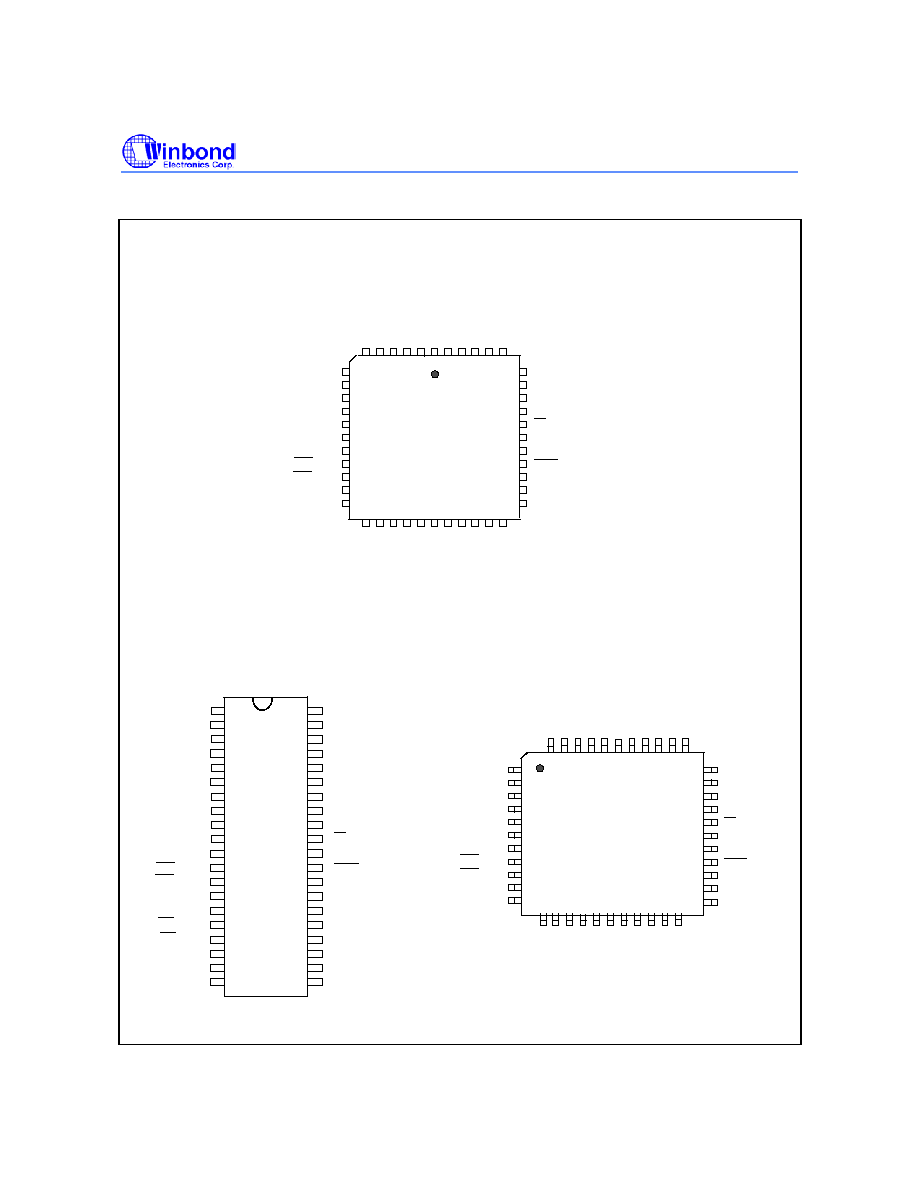
W78E858
- 4 -
3. PIN CONFIGURATIONS
44-pin
PLCC
40
2
1 44 43 42 41
6
5
4
3
39
38
37
36
35
34
33
32
31
30
29
P0.4, AD4
P0.5, AD5
P0.6, AD6
P0.7, AD7
EA
ALE
PSEN
P2.7, A15
P2.6, A14
P2.5, A13
28
27
26
25
24
23
22
21
20
19
18
17
10
9
8
7
14
13
12
11
16
15
P1.5
P1.6
P1.7
RST
RXD, P3.0
TXD, P3.1
INT0, P3.2
INT1, P3.3
T0, P3.4
T1, P3.5
X
T
A
L
1
V
S
S
P
2
.
4
,
A
1
2
P
2
.
3
,
A
1
1
P
2
.
2
,
A
1
0
P
2
.
1
,
A
9
P
2
.
0
,
A
8
X
T
A
L
2
P
3
.
7
,
/
R
D
P
3
.
6
,
/
W
R
P4.1
P4.3
P
4
.
0
P
1
.
4
P
1
.
3
P
1
.
2
T
2
E
X
.
P
1
.
1
T
2
.
P
1
.
0
P
4
.
2
V
D
D
A
D
0
.
P
0
.
0
A
D
1
.
P
0
.
1
A
D
2
.
P
0
.
2
A
D
3
.
P
0
.
3
P1.0
P1.1
P1.2
P1.3
P1.4
P1.5
P1.6
P1.7
RST
RXD, P3.0
TXD, P3.1
INT0, P3.2
INT1, P3.3
T0, P3.4
T1, P3.5
W R, P3.6
RD, P3.7
XTAL2
XTAL1
VSS
VCC
P0.0, AD0
P0.1, AD1
P0.2, AD2
P0.3, AD3
P0.4, AD4
P0.5, AD5
P0.6, AD6
P0.7, AD7
EA
ALE
PSEN
P2.7, A15
P2.6, A14
P2.5, A13
P2.4, A12
P2.3, A11
P2.2, A10
P2.1, A9
P2.0, A8
40-pin
DIP
1
2
3
4
5
6
7
8
9
10
11
12
13
14
15
16
17
18
19
20
40
39
38
37
36
35
34
33
32
31
30
29
28
27
26
25
24
23
22
21
34
40 39 38 37 36
33
32
31
30
29
28
27
26
23
P0.4, AD4
P0.5, AD5
P0.6, AD6
P0.7, AD7
EA
P4.1
ALE
PSEN
P2.7, A15
P2.6, A14
P2.5, A13
22
21
20
19
18
17
16
15
14
13
11
4
3
2
1
8
7
6
5
10
9
P1.5
P1.6
P1.7
RST
RXD, P3.0
P4.3
TXD, P3.1
INT0, P3.2
INT1, P3.3
T0, P3.4
T1, P3.5
P
1
.
4
P
1
.
3
P
1
.
2
T
2
E
X
.
P
1
.
1
T
2
.
P
1
.
0
V
D
D
A
D
0
.
P
0
.
0
A
D
1
.
P
0
.
1
A
D
2
.
P
0
.
2
A
D
3
.
P
0
.
3
P
4
.
2
44 43 42 41
12
X
T
A
L
1
V
S
S
P
2
.
4
,
A
1
2
P
2
.
3
,
A
1
1
P
2
.
2
,
A
1
0
P
2
.
1
,
A
9
P
2
.
0
,
A
8
X
T
A
L
2
P
3
.
7
,
/
R
D
P
3
.
6
,
/
W
R
P
4
.
0
35
25
24
44-pin PQFP

W78E858
Publication Release Date: May 5, 2004
- 5 -
Revision A4
4. PIN DESCRIPTION
SYMBOL TYPE
DESCRIPTIONS
EA
I
External Access Enable:
EA
low forces the processor to execute the
external ROM. The ROM address and data will not be present on the bus if
the
EA
pin is high and the program counter is within the 32 KB area.
Otherwise they will be present on the bus.
PSEN
O/H
Program Strobe Enable:
PSEN
enables the external ROM data in the Port 0
address/data bus. When internal ROM access is performed, no
PSEN
strobe
signal outputs originate from this pin.
ALE
O/H
Address Latch Enable: ALE is used to enable the address latch that
separates the address from the data on Port 0. ALE runs at 1/6th of the
oscillator frequency. An ALE pulse is omitted during external data memory
accesses.
RST
I/L
RESET: A high on this pin for two machine cycles while the oscillator is
running resets the device. RST has a Schmitt trigger input stage to provide
additional noise immunity with a slow rising input voltage.
XTAL1
I
Crystal 1: This is the crystal oscillator input. This pin may be driven by an
external clock
XTAL2
O
Crystal 2: This is the crystal oscillator output. It is the inversion of XTAL1.
V
SS
I
Ground: Ground potential.
V
DD
I
Power Supply: Supply voltage for operation.
P0.0
- P0.7 I/O D Port 0: Function is the same as that of the standard 8052.
P1.0
- P1.7 I/O H
Port 1: Function is the same as that of the standard 8052. Port1 also service
the alternative function INT2
- INT9. P1.0 provide a timer2 programmable
clock output. Four channel PWM clock output via P1.4
- P1.7
P2.0
- P2.7 I/O H Port 2: Port 2 is a bi-directional I/O port with internal pull-ups and emits the
high-order address byte during accesses external memory
P3.0
- P3.7 I/O H Port 3: Function is the same as that of the standard 8052
P4.0
- P4.3 I/O H Port 4: Function is the same as Port1
* Note: TYPE I: input, O: output, I/O: bi-directional, H: pull-high, L: pull-low, D: open drain
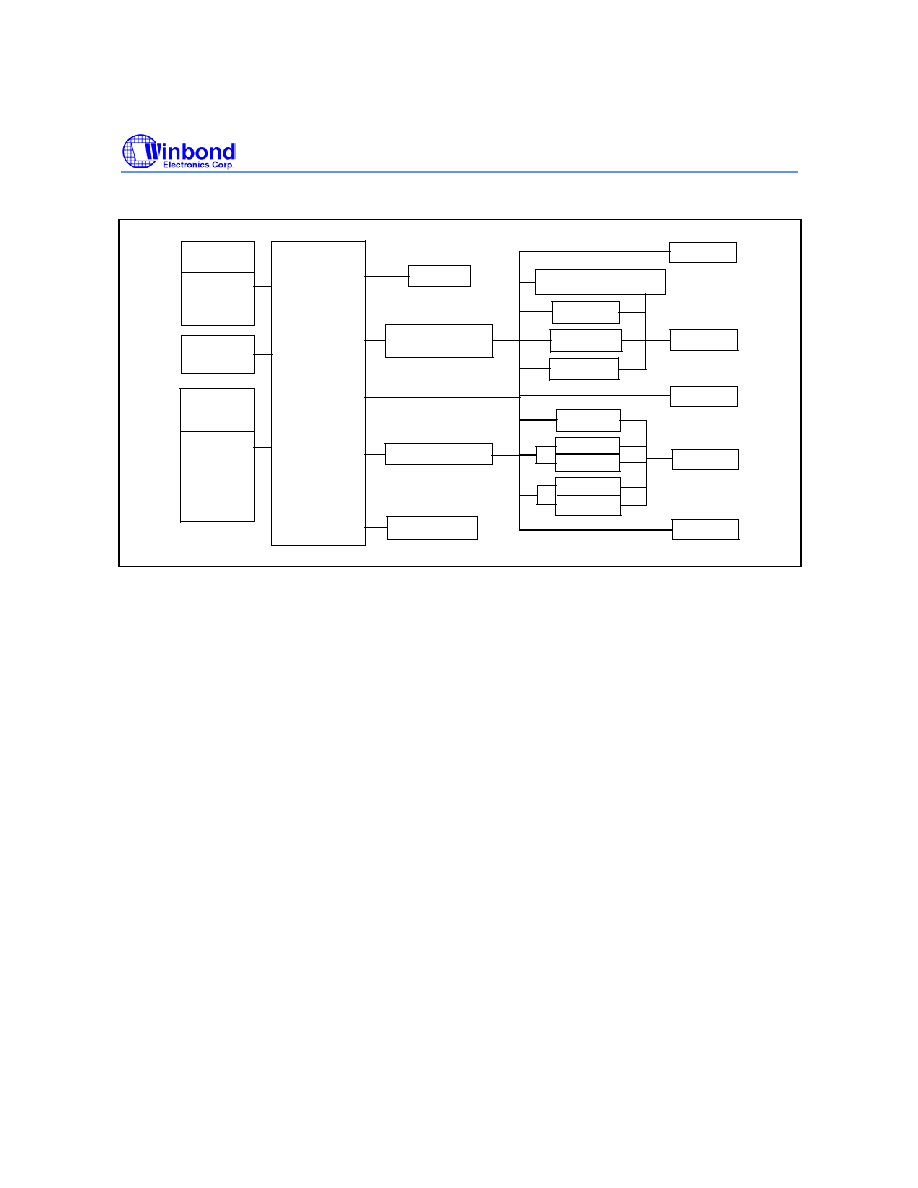
W78E858
- 6 -
5. BLOCK DIAGRAM
RAM
256
RAM 256
Auxiliary
RAM 512
Bytes
Bytes
Auxiliary
MTP-ROM
4K Bytes
Main
MTP-ROM
32K Bytes
CPU
Core
SFR
PORT0
PORT1
PORT2
PORT4
TIMER2
PW M
TIMER1
INT0
INT1
INT2~9
W atch-dog
UART
TIMER0
PORT3
Power Down
W ake Up
EEPROM
128 Bytes
PROGRAMMABLE
CLOCK OUTPUT
Interrupts
8051
Data Bus
6. FUNCTIONAL DESCRIPTION
The W78E858 architecture consists of a core controller surrounded by various registers, four 8-bit
general purpose I/O ports, one 4-bits general purpose I/O port, 256 bytes data RAM and 512 bytes
auxiliary RAM, 128 bytes embedded EEPROM memory, three timer/counters, one serial port, 17-bit
watch-dog timer, 8-bit four channels PWM, programmable timer2 clock output, extra external
interrupts INT2 to INT9, power-down wake up via external interrupts INT0
- INT9. The CPU supports
111 different op-codes and references both a 64K program address space and a 64 K data storage
space.
6.1 RAM
The internal data RAM in W78E858
is 768 bytes. It is divided into two banks: 256 bytes of data RAM
and 512 bytes of auxiliary RAM. These RAM are addressed by different ways.
� RAM 00H - 7FH can be addressed directly and indirectly as the same as in 80C51. Address
pointers are R0 and R1 of the selected register bank.
� RAM 80H - FFH can only be addressed indirectly as the same as in 80C51. Address pointers are
R0, R1 of the selected registers bank.
�
Auxiliary RAM 0000H
- 01FFH is addressed indirectly as the same way to access external data
memory with the MOVX instruction. Address pointers are R0 and R1 of the selected register bank
and DPTR register. By setting ENAUXRAM flag in CHPCON register bit4 to enable on-chip
auxiliary RAM 512 bytes. When the auxiliary RAM is enabled, the data and address will not appear
on P0 and P2, they will keep their previous status that before the MOVX instruction be executed.
Write the page select 00H or 01H to MXPSR register if R0 and R1 are used as address pointer.
When the address of external data memory locations higher than 01FFH or disable auxiliary RAM
512 bytes micro-controller will be performed with the MOVX instruction in the same way as in the
80C51. The auxiliary RAM 512 bytes default is disabled after chip reset.
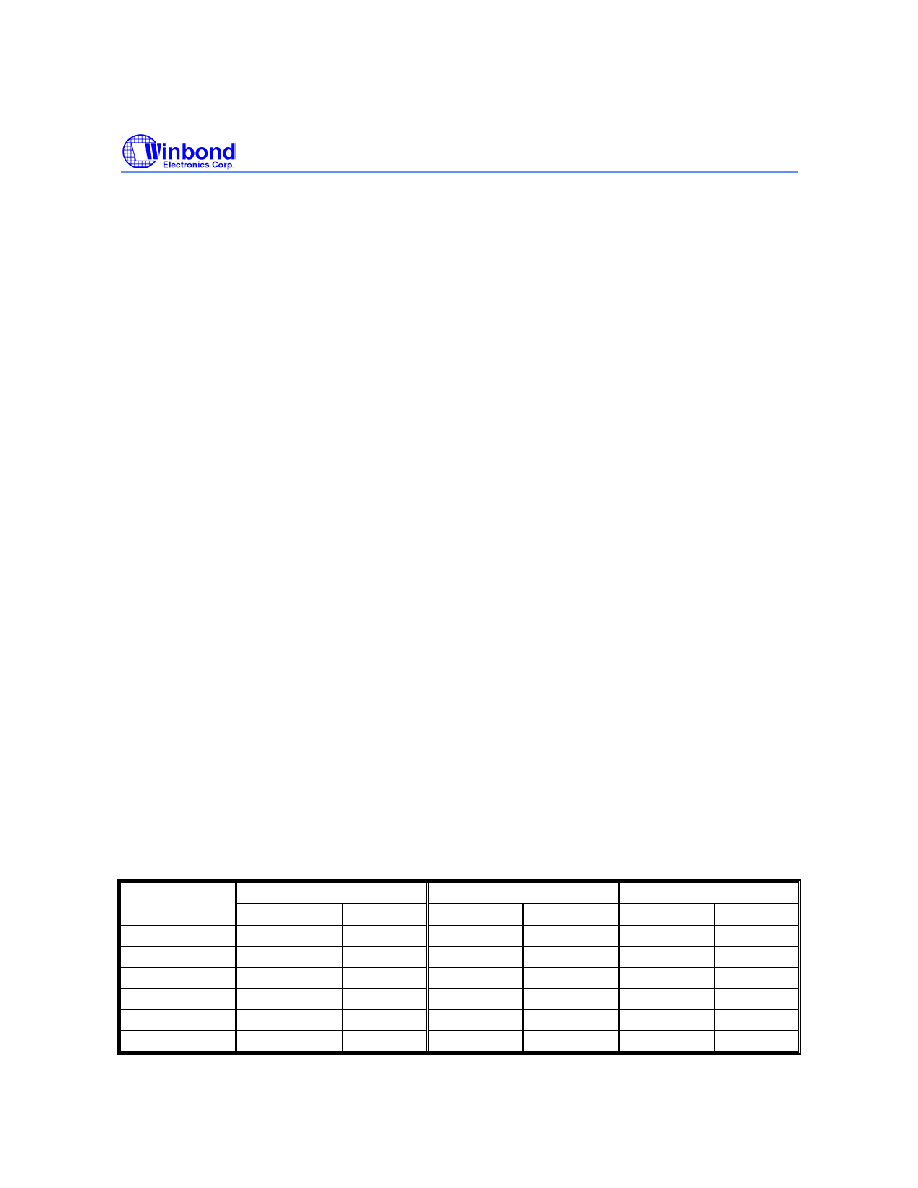
W78E858
Publication Release Date: May 5, 2004
- 7 -
Revision A4
6.2 EEPROM
The 128 bytes EEPROM is defined in external data memory space that located in FF80H-FFFFH in
standard 8-bit series. It is accessed the same as auxiliary RAM512 bytes, the ENEEPROM flag in
CHPCON register bit5 is set. Write the page select 03H to MXPSR register, R0 and R1are used as
address pointer. The EEPROM provided byte write, page write mode and software write protection is
used to protect the data lose when power on or noise. They are described as below:
6.2.1 Byte Write Mode
Once a byte write has been started, it will automatically time itself to completion. A BUSY signal
(MXPSR.7) will be used to detect the end of write operation.
6.2.2 Page Write Mode
The EEPROM is divided into 2 pages and each page contains 64 bytes. The page write allows one to
64 bytes of data to be written into the memory during a single internal programming cycle. Page write
is initiated in the same manner as byte write mode. After the first byte is written, it can then be
followed by one to 63 additional bytes. If a second byte is written within a byte-load cycle time (TBLC)
of 150us, the EEPROM will stay at page load cycle. Additional bytes can then be loaded
consecutively. The page load cycle will be terminated and the internal programming cycle will start if
no additional byte is load within 300us from the last byte be loaded. The address bit6 specify the page
address. All bytes that are loaded to the buffer must have the same page address. The data for page
write may be loaded in any order, the sequential loading is not required.
6.2.3 Software Protected Data Write
The EEPROM provides a JEDED-approved optional software-protected data write. Once this scheme
is enabled, any write operation requires a series of three-byte program commands (with specific data
to a specific address) to be performed before the data load operation. The three-byte load command
sequence begins the page load cycle, without which the write operation will not activated. This write
scheme provides optimal protection against inadvertent write cycles, such as cycles triggered by noise
during system power-up or power-down. Once enabled, the software data protection will remain
enabled unless the disable commands are issued. To reset the device to unprotected mode, a six-
byte command sequence is required.
The address mapping of the external memory is given as following, if ENAUXRAM or ENEEPROM
flags in CHPCON is not set, the CPU will access external memory instead of the on-chip memory. The
data, address and read/write strobe signal will appear on relative IO port just like standard 80C52.
6.2.4 Command Codes for Software Data Protection Enable/Disable and Software Erase
BYTE
ENABLE WRITE PROTECT
DISABLE WRITE PROTECT
SOFTWARE ERASE
SEQUENCE ADDRESS
DATA ADDRESS
DATA ADDRESS
DATA
0
Write FFD5H AAH FFD5H AAH FFD5H AAH
1
Write FFAAH 55H FFAAH 55H FFAAH 55H
2 Write
FFD5H
A0H
FFD5H
80H
FFD5H
80H
3 Write
-
-
FFD5H
AAH
FFD5H
AAH
4 Write
-
-
FFAAH
55H
FFAAH
55H
5 Write
-
-
FFD5H
20H
FFD5H
10H

W78E858
- 8 -
Auiliary RAM 512 Bytes
0000H
01FFH
0200H
EEPROM 128 Bytes
FF80H
FFFFH
External M emory
Fig. On-Chip External Memory Addressed Mapping
(a) Standard 51 Series
6.3 Demo Code:
EEPROM_BASE EQU FF80H
org 0000h
jmp start
org 500h
start:
mov chpenr,#87h
mov chpenr,#59h
orl chpcon,#00100000b ; enable eeprom
mov chpenr,#00h
call enable_protect
mov dptr,#EEPROM_BASE
mov r0,#40h ; only write up to 64
byte/page. Write from FF80h to FFBFh.
mov r1,#55h ; write 55 data.
call write_eeprom_block
call enable_protect ; Call it before writing
mov dptr,#EEPROM_BASE+40h
mov r0,#40h ; Write from FFC0h to FFFFh
address.
mov r1,#55h
call write_eeprom_block
mov dptr,#EEPROM_BASE
mov r0,#80h
mov r1,#55h
call read_eeprom_block
jc $error
mov chpenr,#87h
mov chpenr,#59h
anl chpcon,#11011111b ; disable eeprom
mov chpenr,#00h
clr c
jmp $end

W78E858
Publication Release Date: May 5, 2004
- 9 -
Revision A4
$error:
mov chpenr,#87h
mov chpenr,#59h
anl chpcon,#11011111b ; disable eeprom
mov chpenr,#00h
setb c
$end:
sjmp $
;-----------------------------------------------------------------
disable_protect:
mov dptr,#EEPROM_BASE+55h
mov a,#aah
movx @dptr,a
mov dptr,#EEPROM_BASE+2ah
mov a,#55h
movx @dptr,a
mov dptr,#EEPROM_BASE+55h
mov a,#80h
movx @dptr,a
mov dptr,#EEPROM_BASE+55h
mov a,#aah
movx @dptr,a
mov dptr,#EEPROM_BASE+2ah
mov a,#55h
movx @dptr,a
mov dptr,#EEPROM_BASE+55h
mov a,#20h
movx @dptr,a
call busy_waiting
ret
;-----------------------------------------------------------------
eeprom_erase:
mov dptr,#EEPROM_BASE+55h
mov a,#aah
movx @dptr,a
mov dptr,#EEPROM_BASE+2ah
mov a,#55h
movx @dptr,a
mov dptr,#EEPROM_BASE+55h
mov a,#80h
movx @dptr,a
mov dptr,#EEPROM_BASE+55h
mov a,#aah
movx @dptr,a
mov dptr,#EEPROM_BASE+2ah ;a5~a0
mov a,#55h
movx @dptr,a
mov dptr,#EEPROM_BASE+55h
mov a,#10h
movx @dptr,a
call busy_waiting
ret
;-----------------------------------------------------------------

W78E858
- 10 -
enable_protect:
mov dptr,#EEPROM_BASE+55h
mov a,#aah
movx @dptr,a
mov dptr,#EEPROM_BASE+2ah
mov a,#55h
movx @dptr,a
mov dptr,#EEPROM_BASE+55h
mov a,#a0h
movx @dptr,a
ret
;-----------------------------------------------------------------
busy_waiting:
$wait1:
mov a,mxpsr
jnb acc.7,$wait1
$wait0:
mov a,mxpsr
jb acc.7,$wait0
ret
;----------------------------------------------------------------
write_eeprom_block:
;input r0:counter
;input r1:pattern form
;input dptr:eeprom base address
$write_loop:
mov a,r1
movx @dptr,a
inc dpl
djnz r0,$write_loop
call busy_waiting
ret
;----------------------------------------------------------------
read_eeprom_block:
;input r0:counter
;input r1:pattern form
;input dptr:eeprom base address
;output setb c --> fail
push b
$read_loop:
movx a,@dptr
mov b,a
mov a,r1
cjne a,b,$error
inc dpl
djnz r0,$read_loop
clr c
jmp $end
$error:
setb c
$end:
pop b
ret
.end

W78E858
Publication Release Date: May 5, 2004
- 11 -
Revision A4
6.4 On-chip Flash EPROM
The W78E858 includes two banks of FLASH EPROM. One is 32K bytes of main FLASH EPROM for
application program (APROM) and another 4K bytes of FLASH EPROM for loader program (LDROM)
when operating the in-system programming feature. In normal operation, the micro-controller will
execute the code from the 32K bytes of APROM. By setting program registers, user can force CPU to
switch to the programming mode which will execute the code (loader program) from the 4K bytes of
auxiliary LDROM, and this loader program is going to update the contents of the 32K bytes of
APROM. After chip reset, the micro-controller executes the new application program in the APROM.
This in-system programming feature makes the job easy and efficient in which the application needs
to update firmware frequently. In some applications, the in-system programming feature make it
possible that end-user is able to easily update the system firmware by themselves without opening
the chassis.
6.5 Timers 0, 1, and 2
Timers 0, 1, and 2 each consist of two 8-bit data registers. These are called TL0 and TH0 for Timer 0,
TL1 and TH1 for Timer 1, and TL2 and TH2 for Timer 2. The TCON and TMOD registers provide
control functions for timers 0, 1. The T2CON register provides control functions for Timer 2. RCAP2H
and RCAP2L are used as reload/capture registers for Timer 2.
The operations of Timer 0 and Timer 1 are the same as in the W78C51. Timer 2 is a 16-bit
timer/counter that is configured and controlled by the T2CON register. Like Timers 0 and 1, Timer 2
can operate as either an external event counter or as an internal timer, depending on the setting of bit
C/T2 in T2CON. Timer 2 has three operating modes: capture, auto-reload, and baud rate generator.
The clock speed at capture or auto-reload mode is the same as that of Timers 0 and 1.
6.6 Clock
The W78E858 is designed to use with either a crystal oscillator or an external clock. Internally, the
clock is divided by two before it is used by default. This makes the W78E858 relatively insensitive to
duty cycle variations in the clock.
6.7 Crystal Oscillator
The W78E858 incorporates a built-in crystal oscillator. To make the oscillator work, a crystal must be
connected across pins XTAL1 and XTAL2. In addition, a load capacitor must be connected from each
pin to ground, and a resistor must also be connected from XTAL1 to XTAL2 to provide a DC bias
when the crystal frequency is above 24 MHz.
6.8 External Clock
An external clock should be connected to pin XTAL1. Pin XTAL2 should be left unconnected. The
XTAL1 input is a CMOS-type input, as required by the crystal oscillator. As a result, the external clock
signal should have an input one level of greater than 3.5 volts.
6.9 Power Management
6.9.1 Idle
Mode
The CPU will enter to idle by setting the IDL bit in the PCON register. In the idle mode, the internal
clock to the processor is stopped. The peripherals and the interrupt logic continue to be clocked. The
processor will exit idle mode when either an interrupt or a reset occurs.
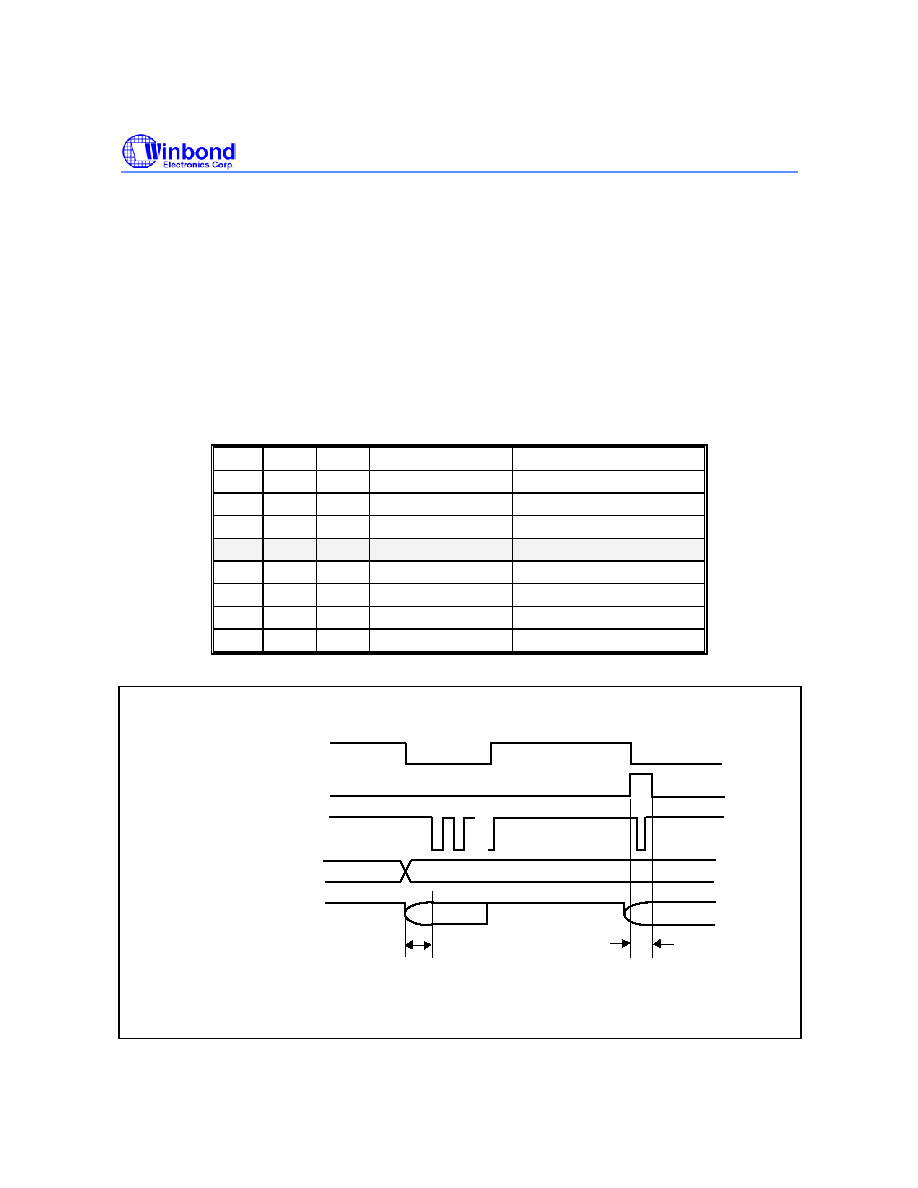
W78E858
- 12 -
6.9.2 Power-down
Mode
When the PD bit of the PCON register is set, the processor enters the power-down mode. In this
mode all of the clocks, including the oscillator are stopped. There are two ways to exit power-down
mode, one is by a chip reset and another is via external interrupts wake up if the related control flags
are enabled.
6.9.3 Wake-up Via External Interrupts INT0 to INT9
If the external interrupts INT0 to INT9 are enabled, the W78E858 can be awakened from power down
mode with the external interrupts if the EA flag in IE register and related interrupt enable is set before
enter power down mode. To ensure that the oscillator is stable before the controller starts, the internal
clock will remain inactive for some oscillator periods. This is controlled by a on-chip delay counter.
The delay time is software selectable and the reset default value is 1536 periods. By setting the PS2
-
PS0 bits in AUXR register the delay periods is given as below:
PS2 PS1 PS0 DELAY
PERIODS
DELAY TIME (20 MHZ)
0 0 0
192
0.0096
mS
0 0 1
384
0.0192
mS
0 1 0
768
0.0384
mS
0
1
1
1536
0.0768 mS
1 0 0
3072
0.1536
mS
1 0 1
6144
0.372
mS
1 1 0
12288
0.6144
mS
1 1 1
24576
1.2288
mS
Interrupt IN0~INT9
Oscillator
RESET-Pin
Power-Down
delay counter x Tosc
> 24 x Tosc
....
...
Internal Clock
Fig. Power-Down W ake Up Operation
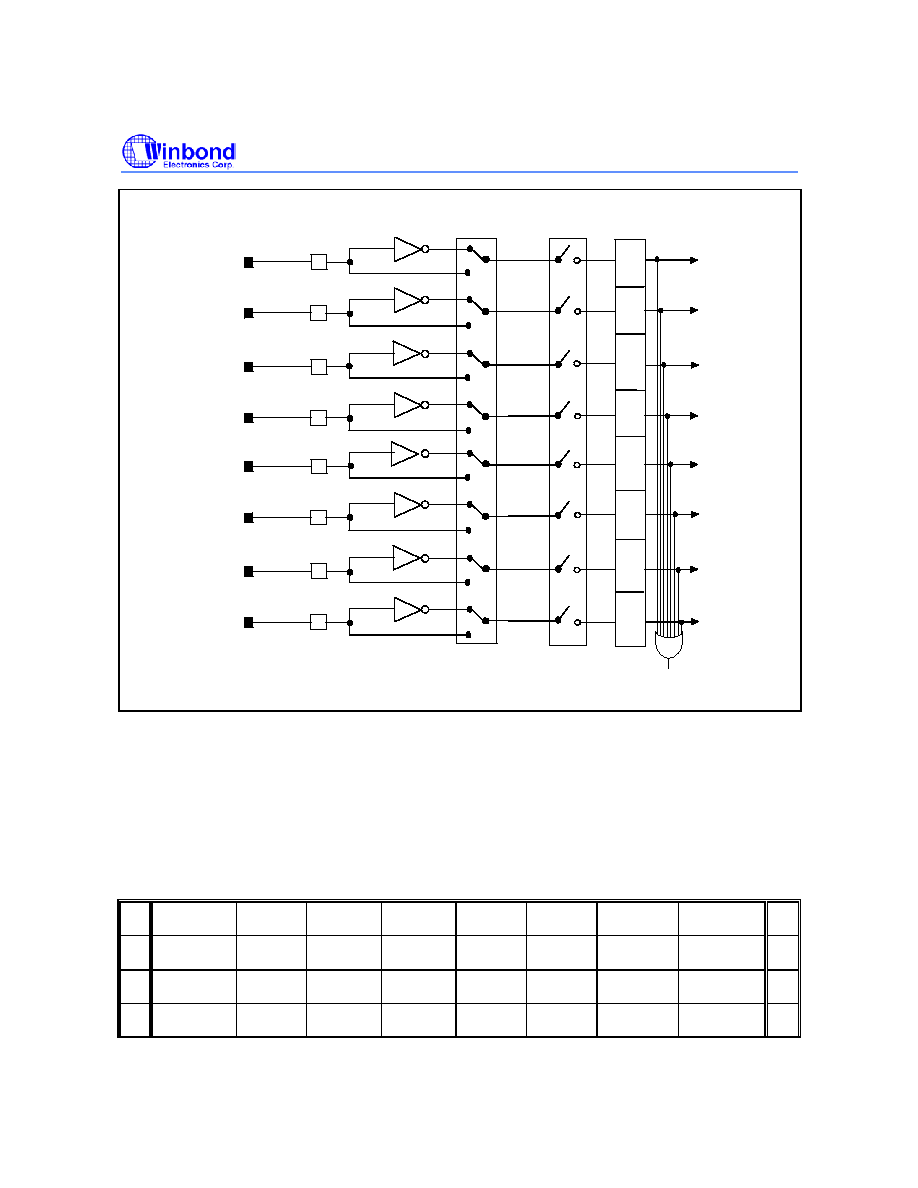
W78E858
Publication Release Date: May 5, 2004
- 13 -
Revision A4
OR8
W ake Up
P1.7
P1.6
P1.5
P1.4
P1.3
P1.2
P1.1
P1.0
IX1
IEN1
IRQ1
X9
X2
X3
X4
X5
X6
X7
X8
Fig. Port1 External Interrupt Configuration
6.10 Reset
The external RST signal is sampled at S5P2. To take effect, it must be held high for at least two
machine cycles while the oscillator is running. An internal trigger circuit in the reset line is used to
deglitch the reset line when the RA80xx is used with an external RC network. The reset logic also has
a special glitch removal circuit that ignores glitches on the reset line. During reset, the ports are
initialized to FFH, the stack pointer to 07H, PCON (with the exception of bit 4) to 00H, and all of the
other SFR registers except SBUF to 00H. SBUF is not reset.
W78E858 Special Function Registers and Reset Values
F8
+IP1
0000000
FF
F0
+B
00000000
CHPENR
00000000
F7
E8
+IE_1
00000000
IX1
00000000
EF
E0
+ACC
00000000
E7
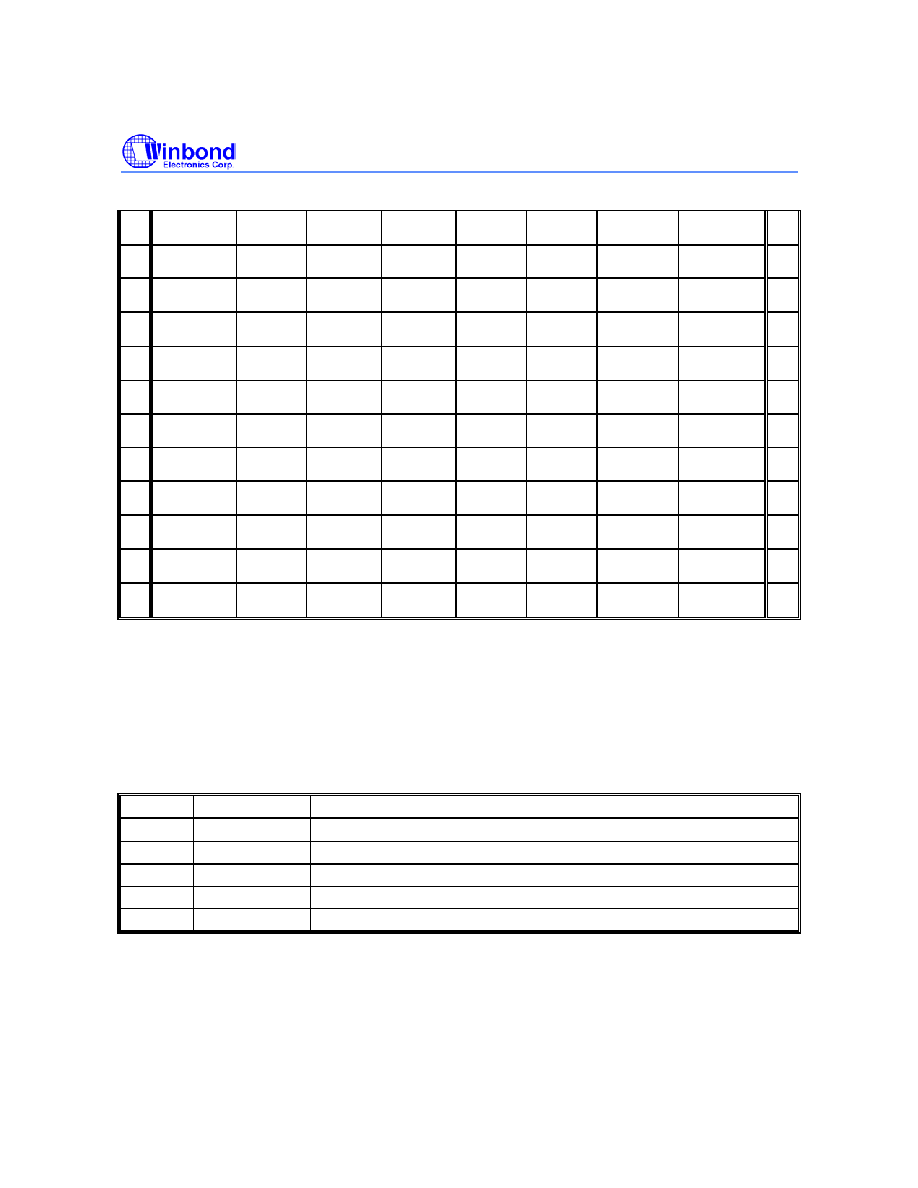
W78E858
- 14 -
W78E858 Special Function Registers and Reset Values, continued
D8
+P4
11111111
DF
D0
+PSW
00000000
D7
C8
+T2CON
00000000
T2MOD
Xxxxxx0x
RCAP2L
00000000
RCAP2H
00000000
TL2
00000000
TH2
00000000
CF
C0
+IRQ1
00000000
SFRAL
00000000
SFRAH
00000000
SFRFD
00000000
SFRCN
00000000
C7
B8
+IP
000000
CHPCON
0xx00000
BF
B0
+P3
00000000
B7
A8
+IE
01000000
AF
A0
+P2
11111111
MXPSR
0xxxxx00
A7
98
+SCON
00000000
SBUF
xxxxxxxx
9F
90
+P1
11111111
PWMCON
xxxx0000
PWMP
00000000
DAC0
00000000
DAC1
00000000
DAC2
00000000
DAC3
00000000
97
88
+TCON
00000000
TMOD
00000000
TL0
00000000
TL1
00000000
TH0
00000000
TH1
00000000
AUXR
xxxx0110
WDTC
000xx000
8F
80
+P0
11111111
SP
00000111
DPL
00000000
DPH
00000000
PCON
00110000
87
Note: the SFRs marked with a plus sign(+) are both byte and bit-addressable.
6.11 Pulse Width Modulator System
The pulse width modulator system of W78E858 contains four PWM output channels with a common 8-
bit counter. These channels generate pulses of programmable length and interval. The prescaler and
counter are common to four PWM channels.
6.11.1 PWMCON (91H)
BIT NAME
FUNCTION
7
- 4
-
Reverse
3
PWM3
Enable P1.7 as PWM clock output.
2
PWM2
Enable P1.6 as PWM clock output.
1
PWM1
Enable P1.5 as PWM clock output.
0
PWM0
Enable P1.4 as PWM clock output.
6.11.2 PWMP (92H)
The prescaler is loaded with the complement of the PWMP register during counter overflow. The
repetition frequency is defined by 8-bit prescaler which clocks the counter. The prescaler division
factor = (PWMP + 1). Reading the PWMP gives the current reload value. The actual count of the
prescaler can't be read.
The PWM counter is enabled with any bit PWMENn (n = 0, 1, 2, 3) of the PWMCON register. Output
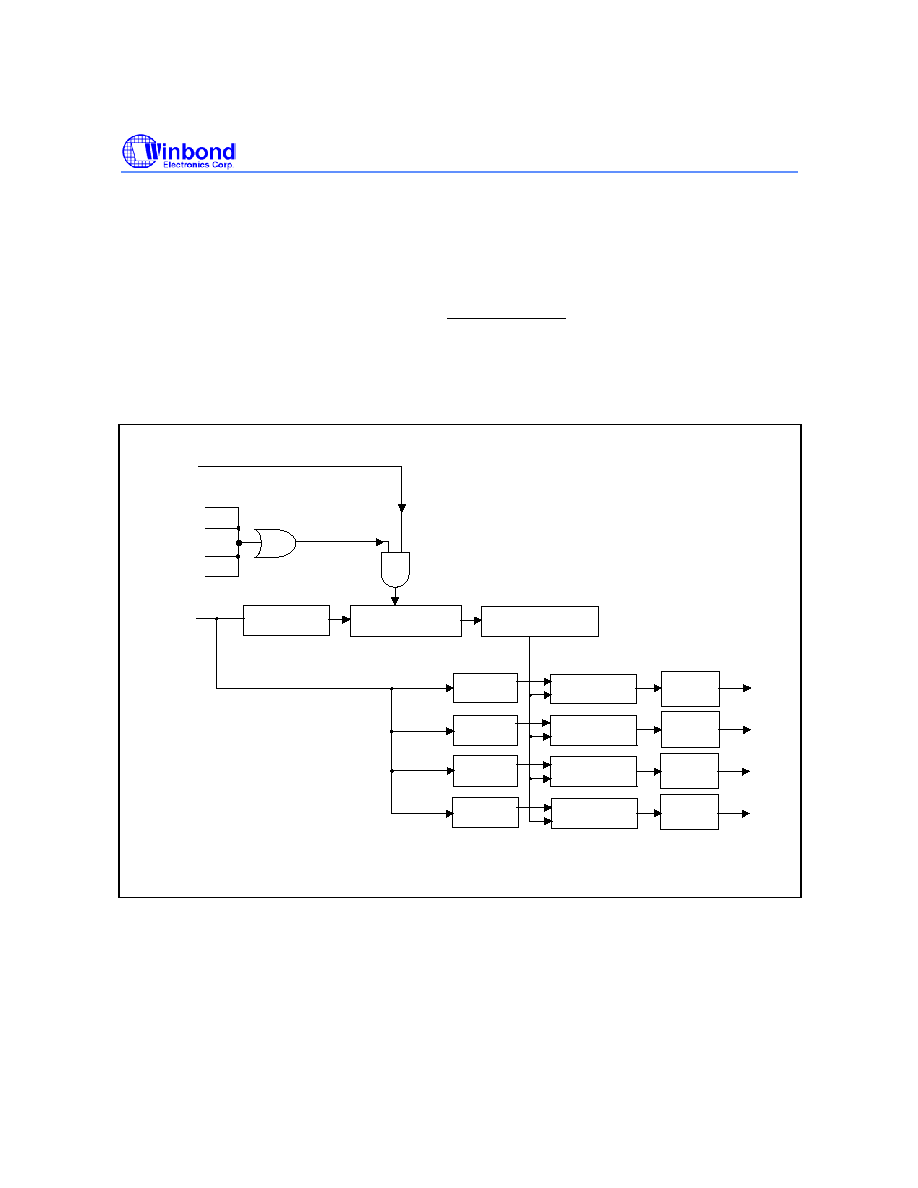
W78E858
Publication Release Date: May 5, 2004
- 15 -
Revision A4
to the port pin is separately enabled by setting the PWMENn bits in the PWMCON register. The PWM
function is reset by a chip reset. In idle mode, the PWM will function as configurated in PWMCON. In
power-down state of the PWM will freeze when the internal clock stops. If the chip is awakened with
an external interrupt, the PWM will continue to function its state when power-down was entered.
The repetition frequency is given by:
Fpwm =
Fosc
[255 x (1+PWMP)]
An oscillator frequency of 24 MHz results in a repetition range of 367.65 Hz to 94.12 KHz. The
high/low ratio of PWMn is DACn/(255-DACn) for DACn values except 255. A DACn value 255 results
in a high PWMn output.
PW MEN0
PW MEN1
PW MEN2
PW MEN3
ENDAC
OR
PW MP SFR
8-BIT PRESCALER
8-BIT UP COUNTER
DAC2
8-BIT DETECT
8-BIT DETECT
DAC3
DAC0
8-BIT DETECT
8-BIT DETECT
DAC1
AND
Fosc
INTERNAL
BUS
OUTPUT
BUFFER
OUTPUT
BUFFER
OUTPUT
BUFFER
OUTPUT
BUFFER
P1.4
P1.5
P1.6
P1.7
Fig. Four Channels 8-Bit PW M Function Block Diagram
6.12 In-system Programming System
The W78E858 provided in-system programming function for new firmware updated. After the related
register and flags are set, user can start timer and force the CPU enter idle mode, then W78E858 will
perform the in-system program mode function specify in SFRCN register, the destination data and
address will come from the related SFR.
The CHPCON is read only by default. Firmware designer must write 87H, 59H sequentially to this

W78E858
- 16 -
special register CHPENR to enable the CHPCON write attribute, and write other value to disable
CHPCON write attribute. This register protects from writing to the CHPCON register carelessly.
6.12.1 SFRAL (C4H)
The programming low-order byte address of FLASH EPROM in-system programming mode
6.12.2 SFRAH (C5H)
The programming high-order byte address of FLASH EPROM in-system programming mode
6.12.3 SFRFD (C6H)
The programming data for on-chip FLASH EPROM in-system programming mode
6.12.4 SFRCN (C7H)
BIT NAME
FUNCTION
7 -
Reserve.
6 WFWIN
On-chip FLASH EPROM bank select for in-system programming.
= 0: 32K bytes FLASH EPROM bank is selected as destination for re-
programming.
= 1: 4K bytes FLASH EPROM bank is selected as destination for re-
programming.
5
OEN
FLASH EPROM output enable.
4
CEN
FLASH EPROM chip enable.
3
- 0
CTRL[3:0] The flash control signals
6.13 In-system Programming Mode Operating Table
MODE CTRL<3:0>
WFWIN
OEN CEN SFRAL SFRAH SFRFD
Erase 32K APROM
0010
0
1
0
X
X
X
Erase 4K LDROM
0010
1
1
0
X
X
X
Program 32K
APROM
0001
0
1
0
Address
Address
Data In
Program 4K LDROM
0001
1
1
0
Address
Address
Data In
Read 32K APROM
0000
0
0
0
Address
Address
Data Out
Read 4K LDROM
0000
1
0
0
Address
Address
Data Out

W78E858
Publication Release Date: May 5, 2004
- 17 -
Revision A4
6.13.1 CHPCON (BFH)
BIT NAME
FUNCTION
7
SWRESET
(F04KMODE)
When this bit is set to 1, and both FBOOTSL and FPROGEN are set to 1. It
will enforce microcontroller reset to initial condition just like power on reset.
This action will re-boot the microcontroller and start to normal operation.
To read this bit can determine that the F04KBOOT mode is running.
6 -
Reserve.
5
ENEEPROM Enable on-chip 128 bytes EEPROM.
4
ENAUXRAM Enable on-chip 512 bytes auxiliary RAM.
3
- 2
- -
1 FBOOTSL
The loader program location selection.
= 0: loader program in 32K memory bank.
= 1: loader program in 4K memory bank.
0 FPROGEN
In system programming enable flag.
= 1: enable. The CPU switches to the programming flash mode after
entering the idle mode and waken up from interrupt. The CPU will
execute the loader program while in on-chip programming mode.
= 0: disable. The on-chip FLASH EPROM read-only. In-system
programmability is inhibit.
6.14 MXPSR (A2H)
BIT NAME
FUNCTION
7 BUSY
EEPROM BUSY signal.
1: EEPROM is writing.
6-2 -
Reserved.
1-0 ADDRPNT
Address pointer by MOVX instruction
0: read or write lower 256 byte Auxiliary RAM by pointer of R0 or R1 register
1: read or write Higher 256 byte Auxiliary RAM by pointer of R0 or R1
register
2: 128 byte EEPROM by pointer of R0 or R1 register
6.15 Interrupt System
External events and the real-time-driven on-chip peripherals require service by the CPU
asynchronous to do execution of any particular section of code. To tie the asynchronous actives of
these functions to normal program execution, a multiple-source, two-priority-level, nested interrupt
system is provided. The W78E858 acknowledges interrupt requests from fourteen sources as below:
� INT0 and INT1

W78E858
- 18 -
� Timer0 and Timer1
� UART serial I/O
� INT2 to INT9 (at Port1)
6.16 External Interrupts INT2 to INT9
Port1 lines serve an alternative purpose at eight additional interrupts INT2 to INT9. When enabled,
each of these lines may "wake-up" the device from power-down mode. Using the IX1 register, the
each pin may be initialized to either active HIGH or LOW. IRQ1 is the interrupt request flag register.
Each flag, if the interrupt is enabled will be set on an interrupt request but must be cleared by
software, i.e. via the interrupt software or when the interrupt is disable.
The Port1 interrupts are level sensitive. A Port1 interrupt will be recognized when a level (HIGH or
LOW depending on Interrupt Polarity Register IX1) on P1.x is held active for at least one machine
cycle. The interrupt request is not served until the next machine cycle.
6.16.1 IE_1 (E8H)
BIT NAME
FUNCTION
7
EX9
Enable external interrupt 9
6
EX8
Enable external interrupt 8
5
EX7
Enable external interrupt 7
4
EX6
Enable external interrupt 6
3
EX5
Enable external interrupt 5
2
EX4
Enable external interrupt 4
1
EX3
Enable external interrupt 3
0
EX2
Enable external interrupt 2
6.16.2 IP1 (F8H)
BIT NAME
FUNCTION
7
PX9
External interrupt 9 priority level
6
PX8
External interrupt 8 priority level
5
PX7
External interrupt 7 priority level
4
PX6
External interrupt 6 priority level
3
PX5
External interrupt 5 priority level
2
PX4
External interrupt 4 priority level
1
PX3
External interrupt 3 priority level
0
PX2
External interrupt 2 priority level

W78E858
Publication Release Date: May 5, 2004
- 19 -
Revision A4
6.16.3 IX1 (E9H)
BIT NAME
FUNCTION
7
IL9
External interrupt 9 polarity level
6
IL8
External interrupt 8 polarity level
5
IL7
External interrupt 7 polarity level
4
IL6
External interrupt 6 polarity level
3
IL5
External interrupt 5 polarity level
2
IL4
External interrupt 4 polarity level
1
IL3
External interrupt 3 polarity level
0
IL2
External interrupt 2 polarity level
6.16.4 IRQ1 (C0H)
BIT NAME
FUNCTION
7
IQ9
External interrupt 9 request flag
6
IQ8
External interrupt 8 request flag
5
IQ7
External interrupt 7 request flag
4
IQ6
External interrupt 6 request flag
3
IQ5
External interrupt 5 request flag
2
IQ4
External interrupt 4 request flag
1
IQ3
External interrupt 3 request flag
0
IQ2
External interrupt 2 request flag
6.16.5 Interrupt Priority and Vector Address
PRIORITY INTERRUPT VECTOR SOURCE PRIORITY INTERRUPT VECTOR SOURCE
1
INT0
0003H
External 0
8
TF1
001BH
Timer 1
2
INT5
0053H
External 5
9
SINT
0023H
UART
3
TF0
000BH
Timer 0
10
TF2
002BH
Timer 2
4
INT6
005BH
External 6
11
INT3
0043H
External 3
5
INT1
0013H
External 1
12
INT8
006BH
External 8
6
INT2
003BH
External 2
13
INT4
004BH
External 4
7
INT7
0063H
External 7
14
INT9
0073H
External 9
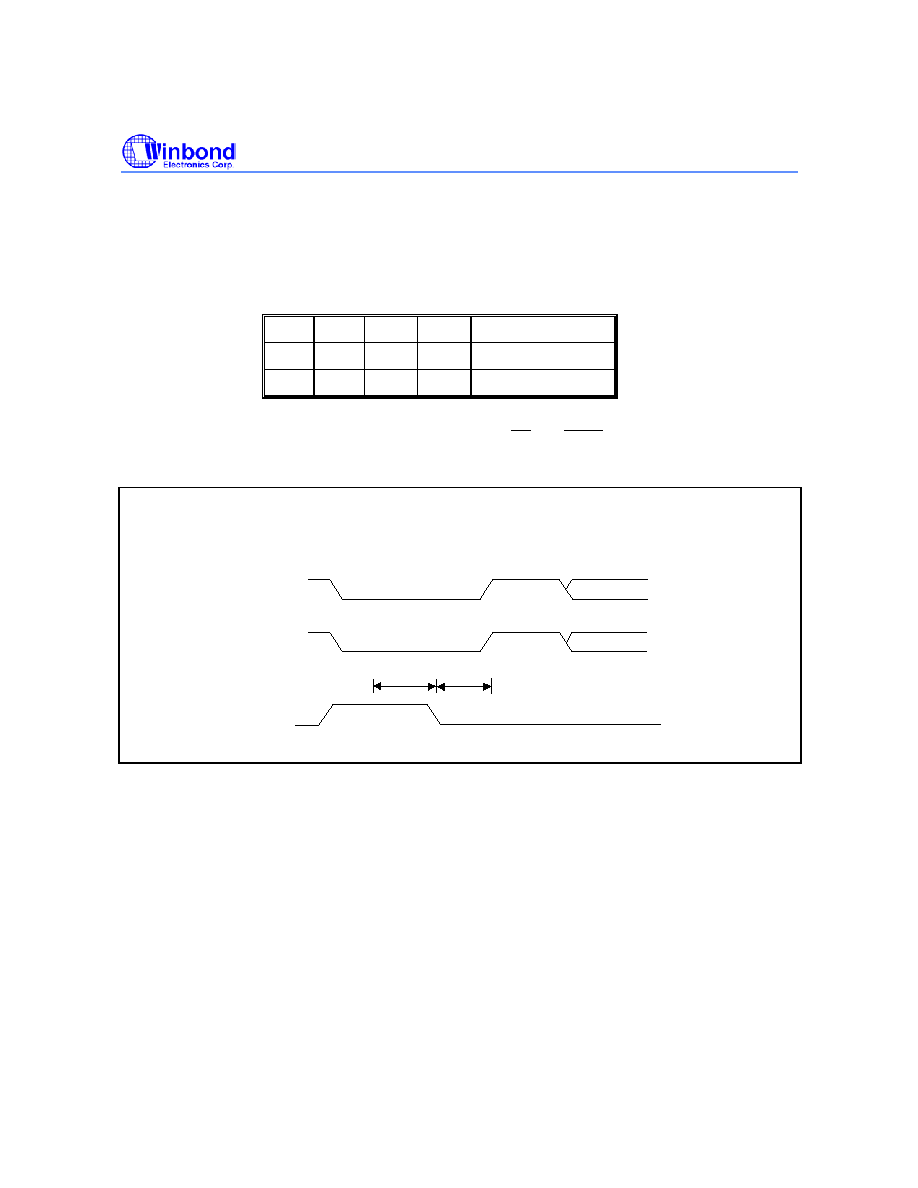
W78E858
- 20 -
6.17 F04KBOOT Mode (Boot From 4K Bytes LDROM)
The W78E858 boots from APROM program (32K bytes bank) by default after chip reset. On some
occasions, user can force the W78E858 to boot from the LDROM program (4K bank) after chip reset.
The setting for this special mode is as follow.
6.17.1 F04KBOOT Mode
RST P4.3 P2.7 P2.6
MODE
H
X L
L FO4KBOOT
H
L X X FO4KBOOT
Note: In application system design, user must take care the P2, P3, ALE,
EA
and
PSEN
pin status at reset to avoid
W78E858 entering the programming mode or F04KBOOT mode in normal operation.
Enter 4K Reboot Mode Timing
Ts=1us
Th > 24 clocks
P2.6
P2.7
X
X
RESET
6.18 Security
During the on-chip FLASH EPROM programming mode, the FLASH EPROM can be programmed and
verified repeatedly. Until the code inside the FLASH EPROM is confirmed OK, the code can be
protected. The protection of FLASH EPROM and those operations on it are described below:
The W78E858 has several special setting registers in FLASH EPROM block. Those bits of the
security register can't be changed once they have been programmed from high to low. They can only
be reset through erase-all operation. The security register is located at the FFFFH on the same bank
with 4K LDROM i.e., P3.6 must set high at writer mode.
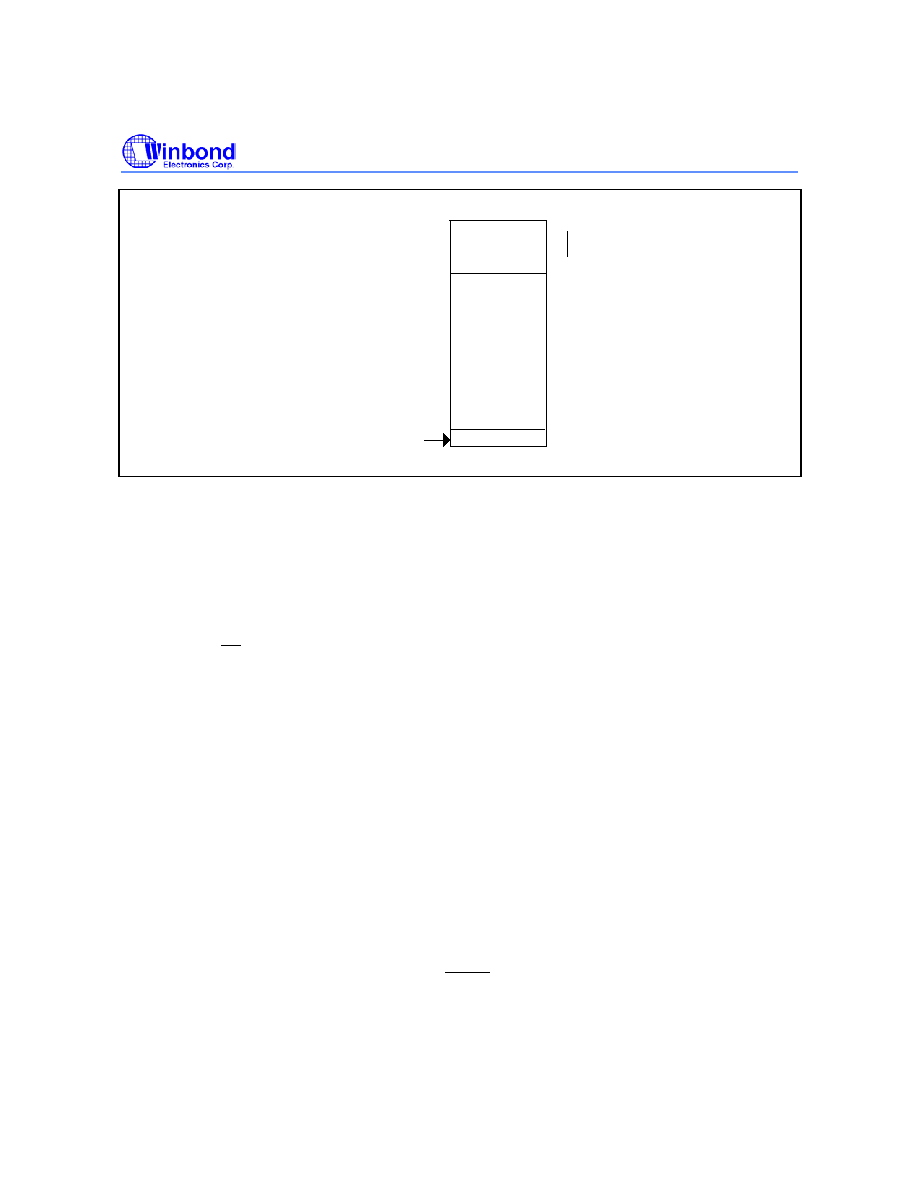
W78E858
Publication Release Date: May 5, 2004
- 21 -
Revision A4
Security Register
4KB LDROM
FFFFH
0000H
0FFEH
On-Chip
Reversed
6.18.1 Lock Bit (Bit0)
This bit is used to protect the customer's program code in the W78E858. It may be set after the
programmer finishes the programming and verifies sequence. Once these bits are set to logic 0, both
the FLASH EPROM data and all data in FLASH EPROM block can't be accessed again.
6.18.2 MOVC Lock (Bit1)
When this bit is program to "0", the MOVC instruction will be disable when the program counter more
than 7FFFh or
EA
pin is forced low.
6.18.3 Scramble Enable (Bit2)
This bit is used to protect the customer's program code in the W78E858. If this bit is set to logic 0, the
dump ROM code are scrambled by a scramble circuit and the dump ROM code will become a random
ROM code.
6.18.4 Oscillator Gain Select (Bit7)
If this bit is set to logic 0 (for 24 MHz), the EMI effect will be reduce. If this bit is set to logic 1 (for 40
MHz), the W78E858 could to use 40 MHz crystal, but the EMI effect is major. So we provide the
option bit which could be chose by customer.
6.19 Watch Dog Timer
For more system reliability, W78E858 provides a programmable watch-dog time-out reset function.
From programming prescaler select, user can choose a variable prescaler from divided by 2 to divided
by 256 to get a suitable time-out period. The time-out period is given by:
T
tim e-out
=
1
Fosc
x
2
14
x
PRESCALER
x 1000 x 12 (mS)
(Note: Fosc unit = Hz)

W78E858
- 22 -
6.19.1 WDTC (8FH)
BIT NAME
FUNCTION
7
ENW
Enable watch-dog timer if set.
6 CLRW
Clear watch-dog timer and prescaler if set. This flag will be cleared auto-
matically.
5 WIDL
If this bit is set, watch-dog is enabled under idle mode. If cleared, watch-dog
is disable under idle mode. Default is cleared.
4
- 3
- Reversed.
2
PS2
Watch-dog prescaler timer select.
1
PS1
Watch-dog prescaler timer select.
0
PS0
Watch-dog prescaler timer select.
PS2 PS1 PS0 PRESCALER
SELCET WATCH-DOG TIME-OUT PERIOD (F
OSC
= 20 MHz)
0 0 0
2
19.66
mS
0 1 0
4
39.32
mS
0 0 1
8
78.64
mS
0 1 1
16
157.28
mS
1 0 0
32
314.57
mS
1 0 1
64
629.14
mS
1 1 0
128
1.25
mS
1 1 1
256
2.52
mS
6.20 Programmable Clock-out
A 50% duty cycle clock can be programmed to come out on P1.0. To configure the timer/counter2 as
a clock generator, bit C/T2 in T2CON register must be cleared and bit T2OE in T2MOD register must
be set. Bit TR2 (T2CON.2) also must be set to start timer. The clock-out frequency depends on the
oscillator frequency and reload value of Timer2 capture register (RCAP2H, RCAP2L) as shown in this
equation:
))
2
,
2
(
65536
(
4
L
RCAP
H
RCAP
frequency
r
oscillatot
-
�
In the clock-out mode, timer2 roll-overs will not generate an interrupt. This is similar to when it is used
as a baud-rate generator. It is possible to use Timer2 as a baud-rate generator and a clock and a
clock generator simultaneously.
6.21 Reduce EMI Emission
The transition of ALE will cause noise, so it cab be turned off to reduce the EMI emission if it is
useless. Turn off the ALE signal transition only need too set the ALEOFF flag in the AUXR register
When ALE is turned off, it will be reactived when program access external ROM or RAM data or jump
to execute external ROM code. After access completely or program returns to internal ROM code,
ALE signal will turn off again.
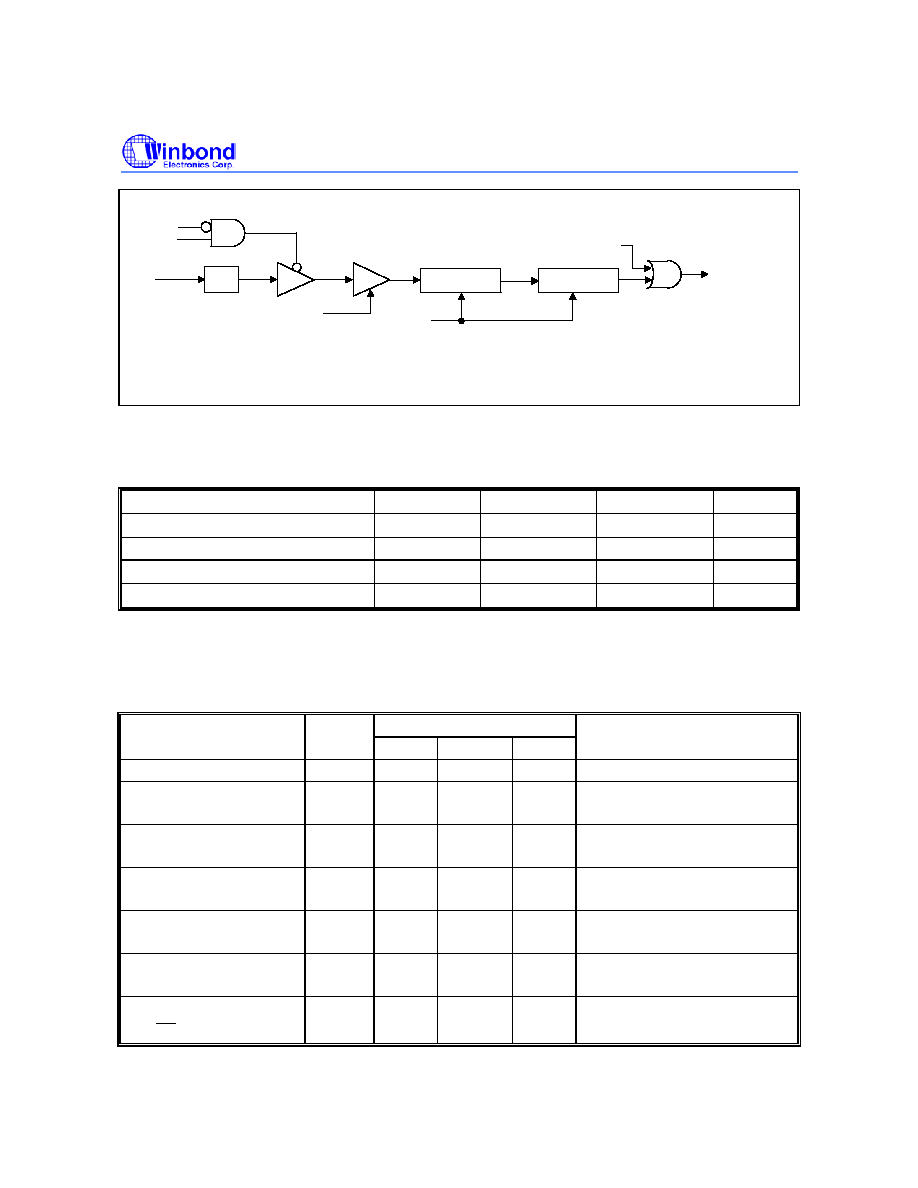
W78E858
Publication Release Date: May 5, 2004
- 23 -
Revision A4
PRESCALER
14-BIT TIMER
EXTERNAL RESET
SYSTEM RESET
ENW
W IDL
IDLE
Fosc
1/12
CLRW
Fig. 17-BIT W atch-Dog Timer Function Block Diagram
7. ELECTRICAL CHARACTERISTICS
7.1 Absolute Maximum Ratings
PARAMETER SYMBOL
MIN.
MAX.
UNIT
DC Power Supply
V
DD
- V
SS
-0.3 +6.0 V
Input Voltage
Vin
V
SS
-0.3
V
DD
+0.3
V
Operating Temperature
Ta
0
70
�C
Storage Temperature
Tst
-55
+150
�C
Note: Exposure to conditions beyond those listed under Absolute Maximum Ratings may adversely affect the life and reliability
of the device.
7.2 D.C. Characteristics
(V
DD
-
V
SS
= 5V
�10%, T
A
= 25
� C, Fosc = 20 MHz, unless otherwise specified.)
SPECIFICATION
PARAMETER SYM.
MIN. MAX. UNIT
TEST CONDITIONS
Operating Voltage
V
DD
4.5
5.5
V
RST = 1, P0 = V
DD
Operating Current
I
DD
- 20
mA
No load
V
DD
= 5.5V
Idle Current
I
IDLE
- 6
mA
Idle mode
V
DD
= 5.5V
Power Down Current
I
PWDN
- 50
�A
Power-down mode
V
DD
= 5.5V
Input Current
P1, P2, P3, P4
I
IN1
-50 +10
�A
V
DD
= 5.5V
V
IN
= 0V or V
DD
Input Current
RST
I
IN2
-10 +300
�A
V
DD
= 5.5V
0 < V
IN
< V
DD
Input Leakage Current
P0,
EA
I
LK
-10 +10
�A
V
DD
= 5.5V
0 < V
IN
< V
DD
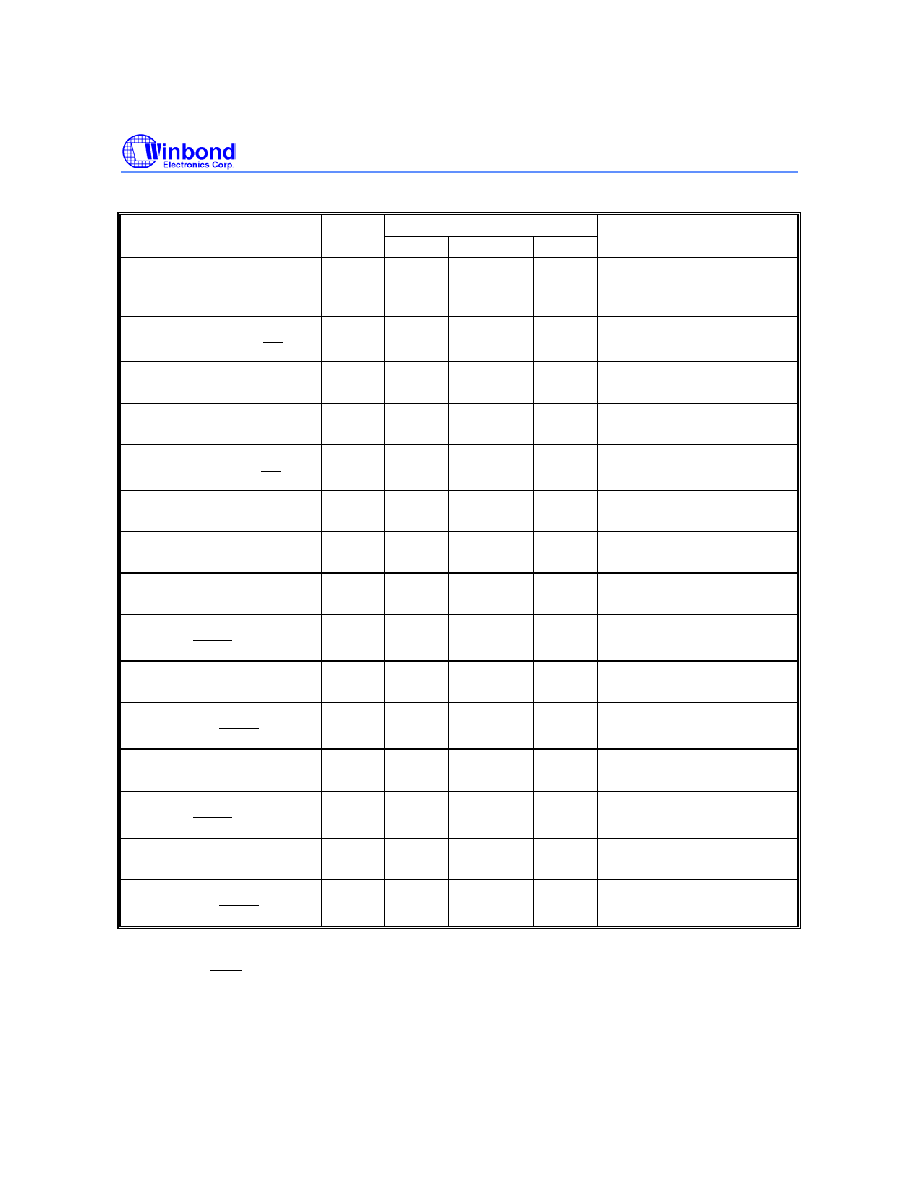
W78E858
- 24 -
D.C. Characteristics, continued
SPECIFICATION
PARAMETER SYM.
MIN. MAX. UNIT
TEST CONDITIONS
Logic 1 to 0 Transition
Current
P1, P2, P3, P4
I
TL
[*4]
-500
-
�A
V
DD
= 5.5V
V
IN
= 2.0V
Input Low Voltage
P0, P1, P2, P3, P4,
EA
V
IL1
0 0.8 V
V
DD
= 4.5V
Input Low Voltage
RST
V
IL2
0 0.8 V
V
DD
= 4.5V
Input Low Voltage
XTAL1
[*4]
V
IL3
0 0.8 V
V
DD
= 4.5V
Input High Voltage
P0, P1, P2,
P3, P4,
EA
V
IH1
2.4 V
DD
+0.2
V
V
DD
= 5.5V
Input High Voltage
RST
V
IH2
3.5 V
DD
+0.2
V
V
DD
= 5.5V
Input High Voltage
XTAL1
[*4]
V
IH3
3.5 V
DD
+0.2
V
V
DD
= 5.5V
Output Low Voltage
P1, P2, P3, P4
V
OL1
- 0.45 V
V
DD
= 4.5V
I
OL
= +2 mA
Output Low Voltage
P0, ALE,
PSEN
[*3]
V
OL2
- 0.45 V
V
DD
= 4.5V
I
OL
= +4 mA
Sink Current
P1, P3, P4
I
SK1
4 12 mA
V
DD
= 4.5V
V
IN
= 0.45V
Sink Current
P0, P2, ALE,
PSEN
I
SK2
10
20 mA
V
DD
= 4.5V
V
IN
= 0.45V
Output High Voltage
P1, P2, P3, P4
V
OH1
2.4 - V
V
DD
= 4.5V
I
OH
= -100
�A
Output High Voltage
P0, ALE,
PSEN
[*3]
V
OH2
2.4 - V
V
DD
= 4.5V
I
OH
= -400
�A
Source Current
P1, P2, P3, P4
I
SR1
-120 -250
�A
V
DD
= 4.5V
V
IN
= 2.4V (latch)
Source Current
P0, P2, ALE,
PSEN
I
SR2
-8 -20 mA
V
DD
= 4.5V
V
IN
= 2.4V
Notes:
*1. RST pin is a Schmitt trigger input.
*3. P0, ALE and
PSEN are tested in the external access mode.
*4. XTAL1 is a CMOS input.
*5. Pins of P1, P2, P3, P4 can source a transition current when they are being externally driven from 1 to 0. The transition
current reaches its maximum value when V
IN
approximates to 2V.
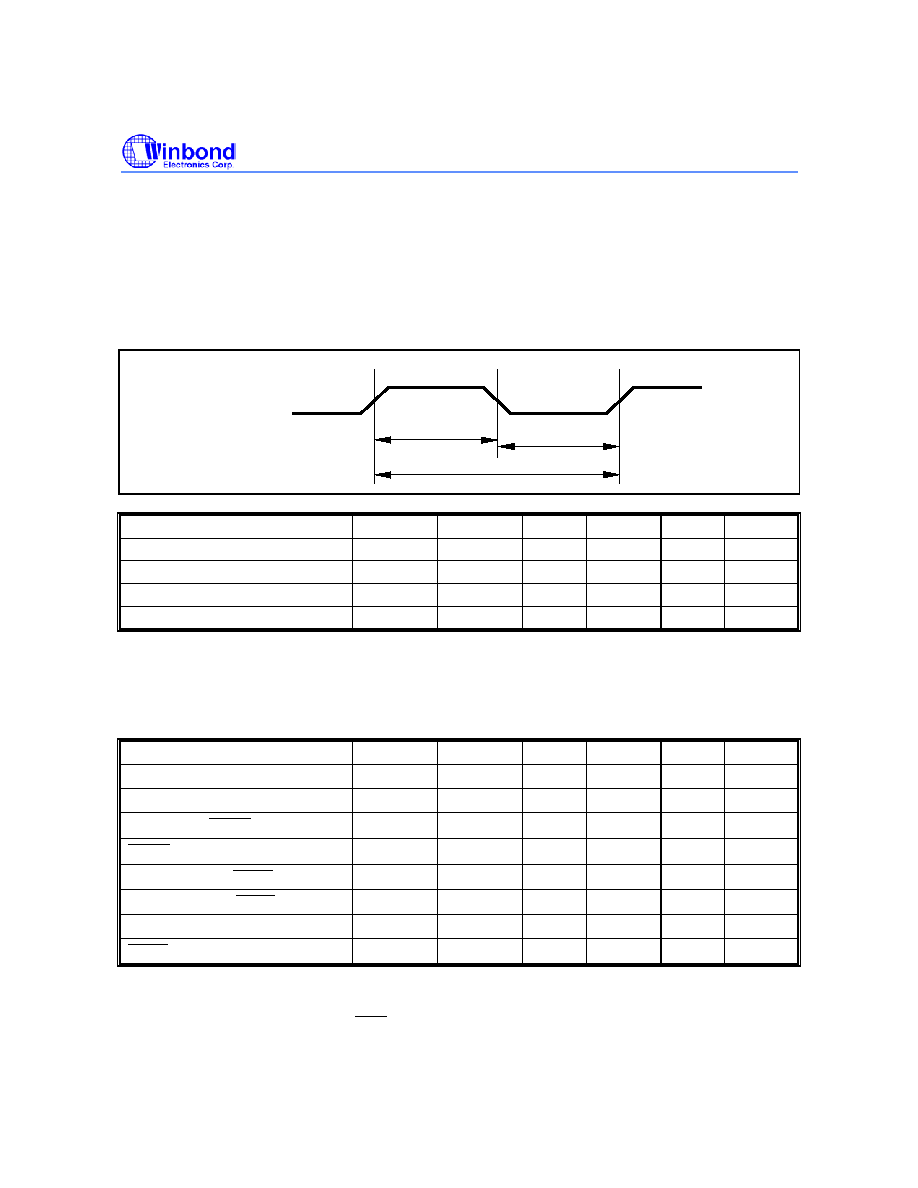
W78E858
Publication Release Date: May 5, 2004
- 25 -
Revision A4
7.3 A.C. Characteristics
The AC specifications are a function of the particular process used to manufacture the part, the
ratings of the I/O buffers, the capacitive load, and the internal routing capacitance. Most of the
specifications can be expressed in terms of multiple input clock periods (T
CP
), and actual parts will
usually experience less than a
�20 nS variation. The numbers below represent the performance
expected from a 0.6 micron CMOS process when using 2 and 4 mA output buffers.
7.3.1 Clock Input Waveform
T
T
XTAL1
F
CH
CL
OP,
T
CP
PARAMETER SYMBOL
MIN.
TYP.
MAX.
UNIT
NOTES
Operating Speed
F
OP
0 -
40
MHz
1
Clock Period
T
CP
25
- - nS 2
Clock High
T
CH
10 - - nS 3
Clock Low
T
CL
10 - - nS
3
Notes:
1. The clock may be stopped indefinitely in either state.
2. The T
CP
specification is used as a reference in other specifications.
3. There are no duty cycle requirements on the XTAL1 input.
7.3.2 Program Fetch Cycle
PARAMETER SYMBOL
MIN.
TYP.
MAX.
UNIT
NOTES
Address Valid to ALE Low
T
AAS
1 T
CP
-
- - nS 4
Address Hold from ALE Low
T
AAH
1 T
CP
-
- - nS
1,
4
ALE Low to
PSEN Low
T
APL
1 T
CP
-
- - nS 4
PSEN Low to Data Valid
T
PDA
- -
2
T
CP
nS 2
Data Hold after
PSEN
High
T
PDH
0
-
1 T
CP
nS 3
Data Float after
PSEN
High
T
PDZ
0
-
1 T
CP
nS
ALE Pulse Width
T
ALW
2 T
CP
-
2 T
CP
-
nS
4
PSEN
Pulse Width
T
PSW
3 T
CP
-
3 T
CP
-
nS
4
Notes:
1. P0.0
-
P0.7, P2.0
-
P2.7 remain stable throughout entire memory cycle.
2. Memory access time is 3 T
CP
.
3. Data have been latched internally prior to PSEN going high.
4. "
" (due to buffer driving delay and wire loading) is 20 nS.

W78E858
- 26 -
7.3.3 Data Read Cycle
PARAMETER SYMBOL
MIN.
TYP.
MAX.
UNIT
NOTES
ALE Low to
RD
Low
T
dar
3 T
CP
-
-
3 T
CP+
nS 1,
2
RD
Low to Data Valid
T
dda
- -
4
T
CP
nS 1
Data Hold from
RD
High
T
ddh
0
-
2 T
CP
nS
Data Float from
RD
High
T
ddz
0 -
2
T
CP
nS
RD
Pulse Width
T
drd
6 T
CP
-
6 T
CP
-
nS
2
Notes:
1. Data memory access time is 8 T
CP
.
2. "
" (due to buffer driving delay and wire loading) is 20 nS.
7.3.4 Data Write Cycle
PARAMETER SYMBOL
MIN.
TYP.
MAX.
UNIT
ALE Low to
WR
Low
T
DAW
3 T
CP
-
-
3 T
CP
+
nS
Data Valid to
WR
Low
T
DAD
1 T
CP
-
- - nS
Data Hold from
WR
High
T
DWD
1 T
CP
-
- - nS
WR
Pulse Width
T
DWR
6 T
CP
-
6 T
CP
-
nS
Note:
"
" (due to buffer driving delay and wire loading) is 20 nS.
7.3.5 Port Access Cycle
PARAMETER SYMBOL
MIN.
TYP.
MAX.
UNIT
Port Input Setup to ALE Low
T
PDS
1
T
CP
- - nS
Port Input Hold from ALE Low
T
PDH
0 - - nS
Port Output to ALE
T
PDA
1
T
CP
- - nS
Note:
Ports are read during S5P2, and output data becomes available at the end of S6P2. The timing data are referenced to
ALE, since it provides a convenient reference.
7.3.6 Flash Mode Timing
PARAMETER SYMBOL
MIN.
TYP.
MAX.
UNIT
NOTES
Reset Valid
T
RV
9 10 11
�S
-
Enter Flash Mode Reset Low
T
EFRL
9 10 11
�S
-
Program Pulse High
T
PPH
18 20 22
�S
-
Program Pulse Low
T
PPL
40 50 60
�S
-
Erase Pulse Low
T
EPL
25 30 50 mS -
Read Pulse Low
T
RPL
1.35 1.5 1.65
�S
-
Address PreFix
T
APF
45 50 55 nS -
Data Remain
T
DR
81 90 99 nS -

W78E858
Publication Release Date: May 5, 2004
- 27 -
Revision A4
8. TIMING WAVEFORMS
8.1 Program Fetch Cycle
S1
XTAL1
S2
S3
S4
S5
S6
S1
S2
S3
S4
S5
S6
ALE
PORT 2
A0-A7
A0-A7
Data
A0-A7
Code
T
A0-A7
Data
Code
PORT 0
PSEN
PDH,
T
PDZ
T
PDA
T
AAH
T
AAS
T
PSW
T
APL
T
ALW
8.2 Data Read Cycle
S2
S3
S5
S6
S1
S2
S3
S4
S5
S6
S1
S4
XTAL1
ALE
PSEN
DATA
A8-A15
PORT 2
PORT 0
A0-A7
RD
T
DDH,
T
DDZ
T
DDA
T
DRD
T
DAR
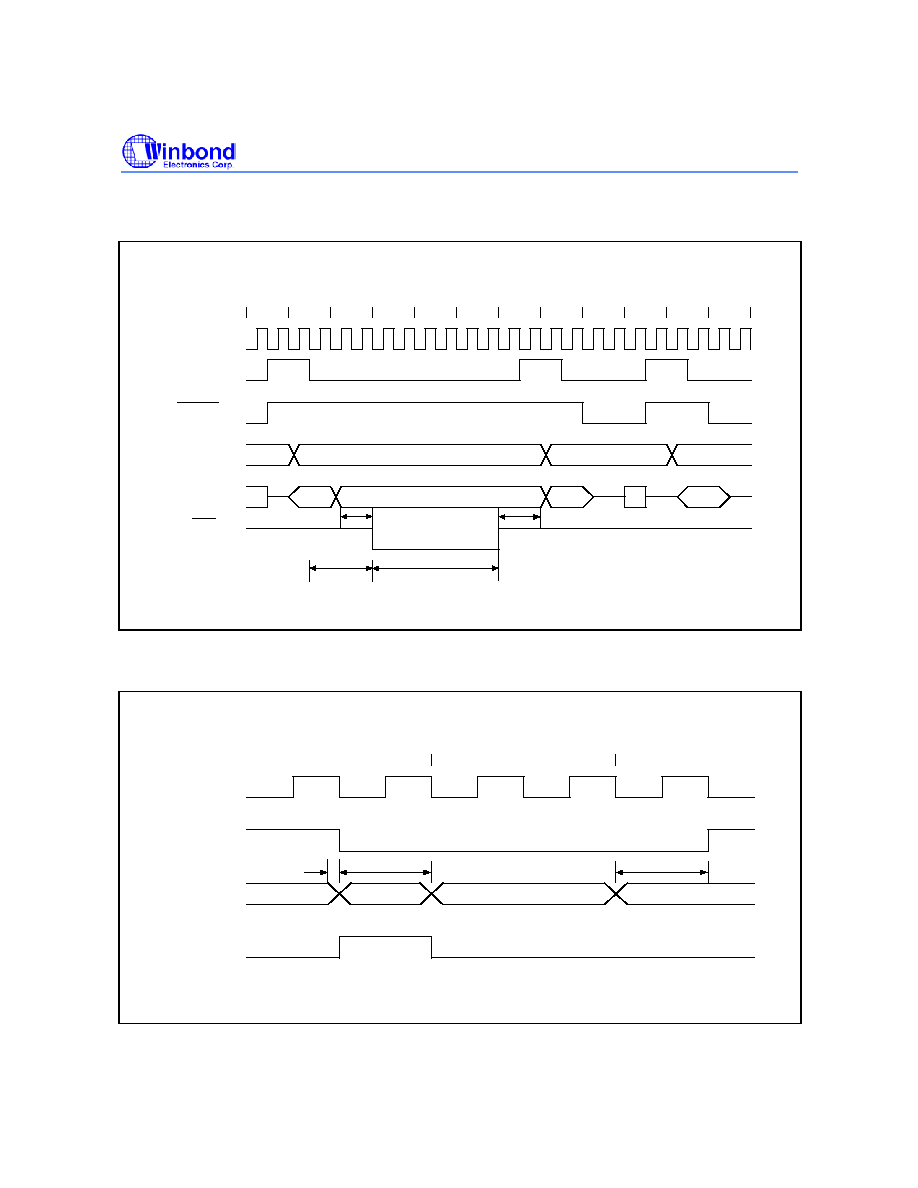
W78E858
- 28 -
Timing Waveforms, continued
8.3 Data Write Cycle
S2
S3
S5
S6
S1
S2
S3
S4
S1
S5
S6
S4
XTAL1
ALE
PSEN
A8-A15
DATA OUT
PORT 2
PORT 0
A0-A7
W R
T
T
DAW
DAD
T
DW R
T
DW D
8.4 Port Access Cycle
XTAL1
ALE
S5
S6
S1
DATA OUT
T
T
PORT
INPUT
T
SAMPLE
PDA
PDH
PDS
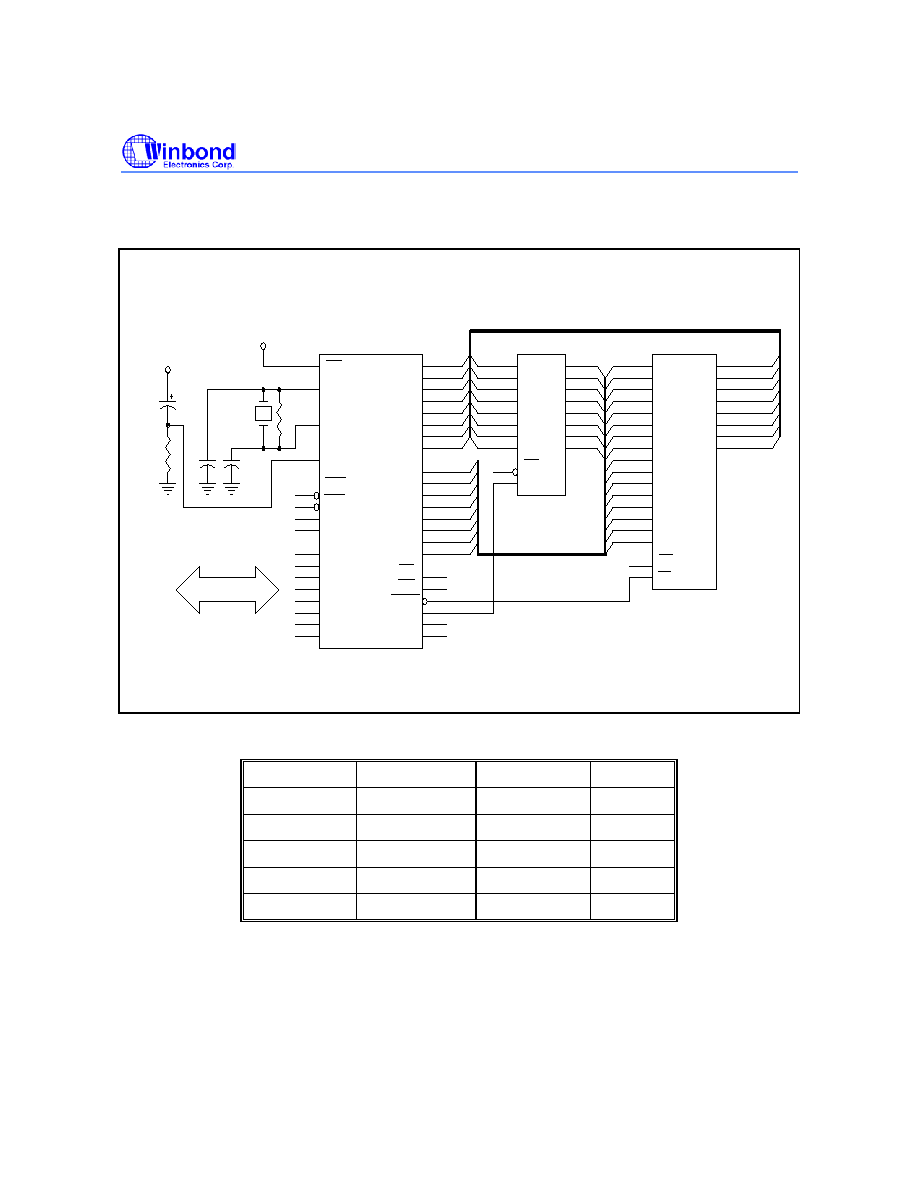
W78E858
Publication Release Date: May 5, 2004
- 29 -
Revision A4
9. TYPICAL APPLICATION CIRCUITS
9.1 Expanded External Program Memory and Crystal
AD0
A0
A0
A0
10
A1
9
A2
8
A3
7
A4
6
A5
5
A6
4
A7
3
A8
25
A9
24
A10
21
A11
23
A12
2
A13
26
A14
27
A15
1
CE
20
OE
22
O0 11
O1 12
O2 13
O3 15
O4 16
O5 17
O6 18
O7 19
2764
AD0
D0
3
Q0 2
D1
4
Q1 5
D2
7
Q2 6
D3
8
Q3 9
D4
13
Q4 12
D5
14
Q5 15
D6
17
Q6 16
D7
18
Q7 19
OC
1
G
11
74LS373
AD0
EA
35
XTAL1
21
XTAL2
22
RST
10
INT0
14
INT1
15
T0
16
T1
17
P1.0
2
P1.1
3
P1.2
4
P1.3
5
P1.4
6
P1.5
7
P1.6
8
P1.7
9
43
42
41
40
39
38
37
36
24
25
26
27
28
29
30
31
19
WR
P0.0
P0.1
P0.2
P0.3
P0.4
P0.5
P0.6
P0.7
P2.0
P2.1
P2.2
P2.3
P2.4
P2.5
P2.6
P2.7
RD
18
PSEN 32
ALE 33
TXD 13
RXD
11
W78E858
10 u
8.2 K
DD
CRYSTAL
C1
C2
R
AD1
AD2
AD3
AD4
AD5
AD6
AD7
A8
AD1
AD2
AD3
AD4
AD5
AD6
AD7
GND
A1
A2
A3
A4
A5
A6
A7
A1
A2
A3
A4
A5
A6
A7
A8
A9
AD1
AD2
AD3
AD4
AD5
AD6
AD7
A10
A11
A12
A13
A14
A15
GND
A9
A10
A11
A12
A13
A14
A15
V
DD
V
Figure A
CRYSTAL C1
C2 R
6 MHz
68P
- 100P
68P
- 100P
6.8K
16 MHz
20P
- 100P
20P
- 100P
6.8K
24 MHz
10P
- 68P
10P
- 68P
6.8K
32 MHz
5P
- 20P
5P
- 20P
6.8K
40 MHz
5P
5P
3.3K
Above table shows the reference values for crystal applications.
Notes:
1. C1, C2, R components refer to Figure A
2. Crystal layout must get close to XTAL1 and XTAL2 pins on user's application board.
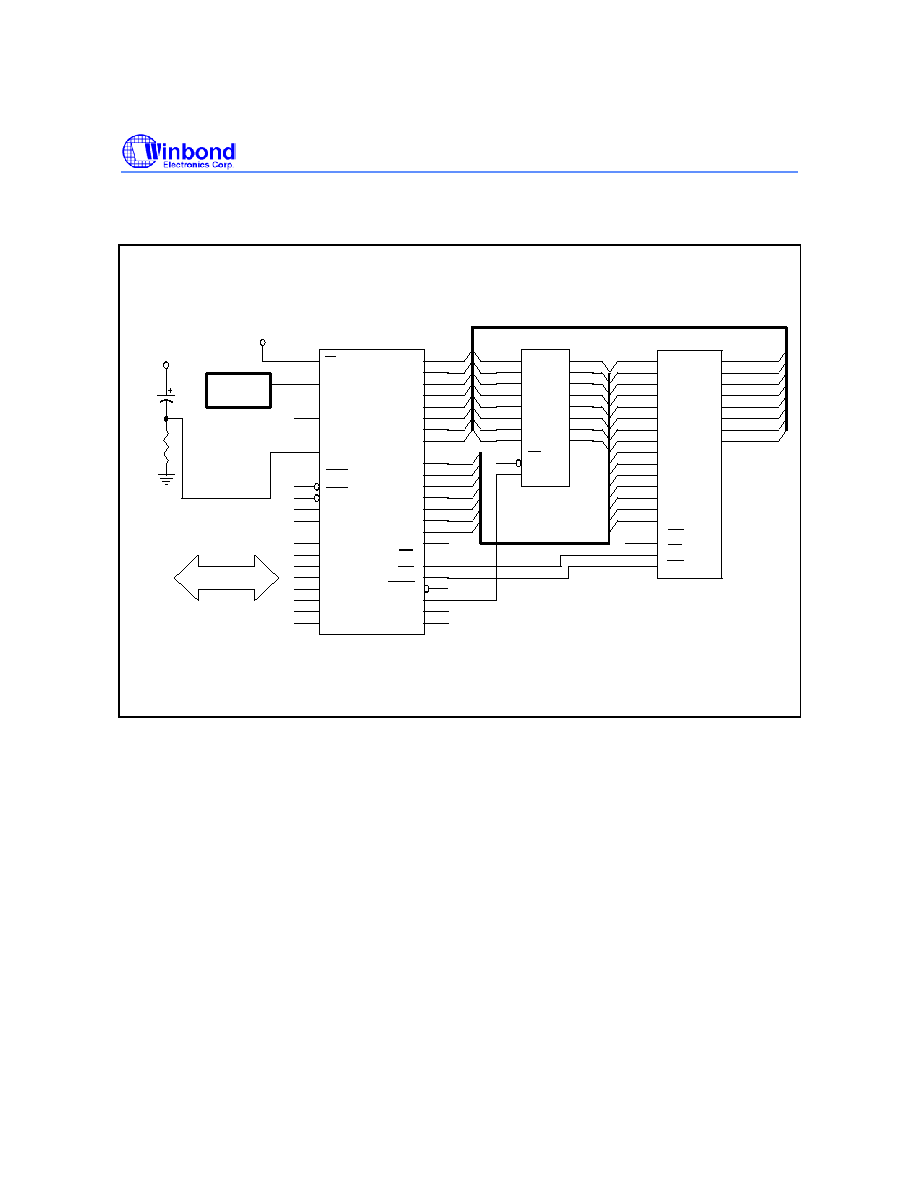
W78E858
- 30 -
Typical Application Circuits, continued
9.2 Expanded External Data Memory and Oscillator
10 u
8.2 K
DD
OSCILLATOR
EA
35
XTAL1
21
XTAL2
20
RST
10
INT0
14
INT1
15
T0
16
T1
17
P1.0
2
P1.1
3
P1.2
4
P1.3
5
P1.4
6
P1.5
7
P1.6
8
P1.7
9
P0.0 43
P0.1 42
P0.2 41
P0.3 40
P0.4 39
P0.5 38
P0.6 37
P0.7 36
P2.0
24
P2.1 25
P2.2
26
P2.3 27
P2.4
28
P2.5
29
P2.6
30
P2.7 31
RD
19
WR
18
PSEN 32
ALE
33
TXD
13
RXD 11
W78E858
AD0
AD1
AD2
AD3
AD4
AD5
AD6
AD7
AD0
AD1
AD2
AD3
AD4
AD5
AD6
AD7
A0
A1
A2
A3
A4
A5
A6
A7
D0
3
Q0 2
D1
4
Q1 5
D2
7
Q2 6
D3
8
Q3 9
D4
13
Q4 12
D5
14
Q5 15
D6
17
Q6 16
D7
18
Q7 19
OC
1
G
11
74LS373
A0
A1
A2
A3
A4
A5
A6
A7
10
9
8
7
6
5
4
3
A0
A1
A2
A3
A4
A5
A6
A7
AD0
AD1
AD2
AD3
AD4
AD5
AD6
AD7
11
12
13
15
16
17
18
19
D0
D1
D2
D3
D4
D5
D6
D7
A8
A9
A10
A11
A12
A13
A14
25
24
21
23
26
1
20
2
A8
A9
A10
A11
A12
A13
A14
CE
GND
A8
A9
A10
A11
A12
A13
A14
GND
22
27
OE
WR
20256
V
DD
V
Figure B
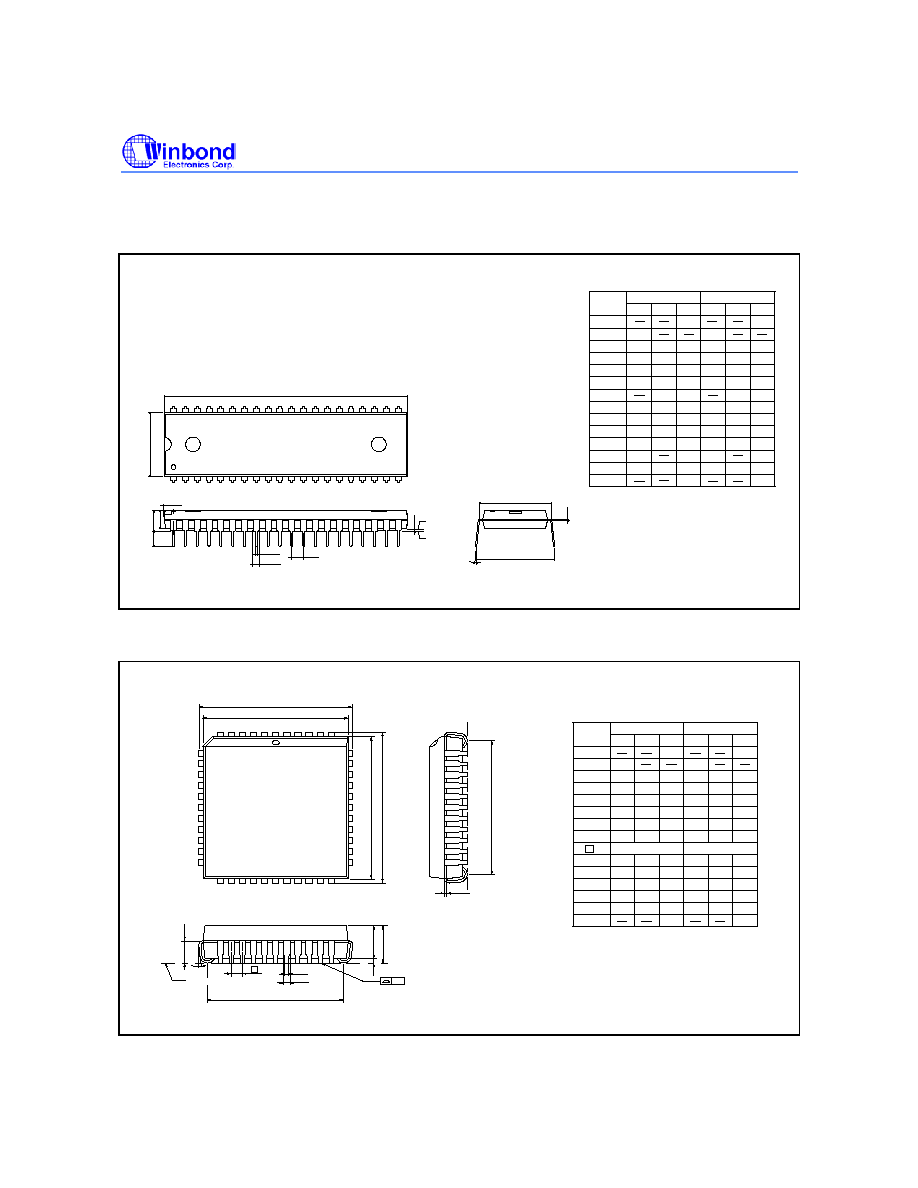
W78E858
Publication Release Date: May 5, 2004
- 31 -
Revision A4
10. PACKAGE DIMENSIONS
10.1 40-pin DIP
Seating Plane
1. Dimension D Max. & S include mold flash or
tie bar burrs.
2. Dimension E1 does not include interlead flash.
3. Dimension D & E1 include mold mismatch and
are determined at the mold parting line.
6. General appearance spec. should be based on
final visual inspection spec.
.
1.372
1.219
0.054
0.048
Notes:
Symbol
Min. Nom. Max.
Max.
Nom.
Min.
Dimension in inch
Dimension in mm
0.050
1.27
0.210
5.334
0.010
0.150
0.016
0.155
0.018
0.160
0.022
3.81
0.406
0.254
3.937
0.457
4.064
0.559
0.008
0.120
0.670
0.010
0.130
0.014
0.140
0.203
3.048
0.254
3.302
0.356
3.556
0.540
0.550
0.545
13.72
13.97
13.84
17.01
15.24
14.986
15.494
0.600
0.590
0.610
2.286
2.54
2.794
0.090
0.100
0.110
A
B
c
D
e
A
L
S
A
A
1
2
E
B
1
1
e
E
1
a
2.055
2.070
52.20
52.58
0
15
0.090
2.286
0.650
0.630
16.00
16.51
protrusion/intrusion.
4. Dimension B1 does not include dambar
5. Controlling dimension: Inches.
15
0
e
A
A
a
c
E
Base Plane
1
A
1
e
L
A
S
1
E
D
1
B
B
40
21
20
1
2
10.2 44-pin PLCC
44
40
39
29
28
18
17
7
6
1
L
c
1
b
2
A
H
D
D
e
b
E
H
E
y
A
A
1
Seating Plane
D
G
G
E
Symbol
Min. Nom. Max.
Max.
Nom.
Min.
Dimension in inch
Dimension in mm
A
b
c
D
e
H
E
L
y
A
A
1
2
E
b
1
H
D
G
G
D
E
Notes:
on final visual inspection spec.
4. General appearance spec. should be based
3. Controlling dimension: Inches
protrusion/intrusion.
2. Dimension b1 does not include dambar
flash.
1. Dimension D & E do not include interlead
0.020
0.145
0.026
0.016
0.008
0.648
0.590
0.680
0.090
0.150
0.028
0.018
0.010
0.653
0.610
0.690
0.100
0.050
BSC
0.185
0.155
0.032
0.022
0.014
0.658
0.630
0.700
0.110
0.004
0.508
3.683
0.66
0.406
0.203
16.46
14.99
17.27
2.296
3.81
0.711
0.457
0.254
16.59
15.49
17.53
2.54
1.27
4.699
3.937
0.813
0.559
0.356
16.71
16.00
17.78
2.794
0.10
BSC
16.71
16.59
16.46
0.658
0.653
0.648
16.00
15.49
14.99
0.630
0.610
0.590
17.78
17.53
17.27
0.700
0.690
0.680

W78E858
- 32 -
Package Dimensions, continued
10.3 44-pin PQFP
Seating Plane
11
22
12
See Detail F
e
b
A
y
1
A
A
L
L
1
c
E
E
H
1
D
44
H
D
34
33
Detail F
1. Dimension D & E do not include interlead
flash.
2. Dimension b does not include dambar
protrusion/intrusion.
3. Controlling dimension: Millimeter
4. General appearance spec. should be based
on final visual inspection spec.
0.254
0.101
0.010
0.004
Notes:
Symbol
Min. Nom. Max.
Max.
Nom.
Min.
Dimension in inch
Dimension in mm
A
b
c
D
e
H
D
H
E
L
y
A
A
L
1
1
2
E
0.006
0.152
---
0.002
0.075
0.01
0.081
0.014
0.087
0.018
1.90
0.25
0.05
2.05
0.35
2.20
0.45
0.390
0.025
0.063
0.003
0
7
0.394
0.031
0.398
0.037
9.9
0.80
0.65
1.6
10.00
0.8
10.1
0.95
0.398
0.394
0.390
0.530
0.520
0.510
13.45
13.2
12.95
10.1
10.00
9.9
7
0
0.08
0.031
0.01
0.02
0.25
0.5
---
---
---
---
---
2
0.025
0.036
0.635
0.952
0.530
0.520
0.510
13.45
13.2
12.95
0.051
0.075
1.295
1.905
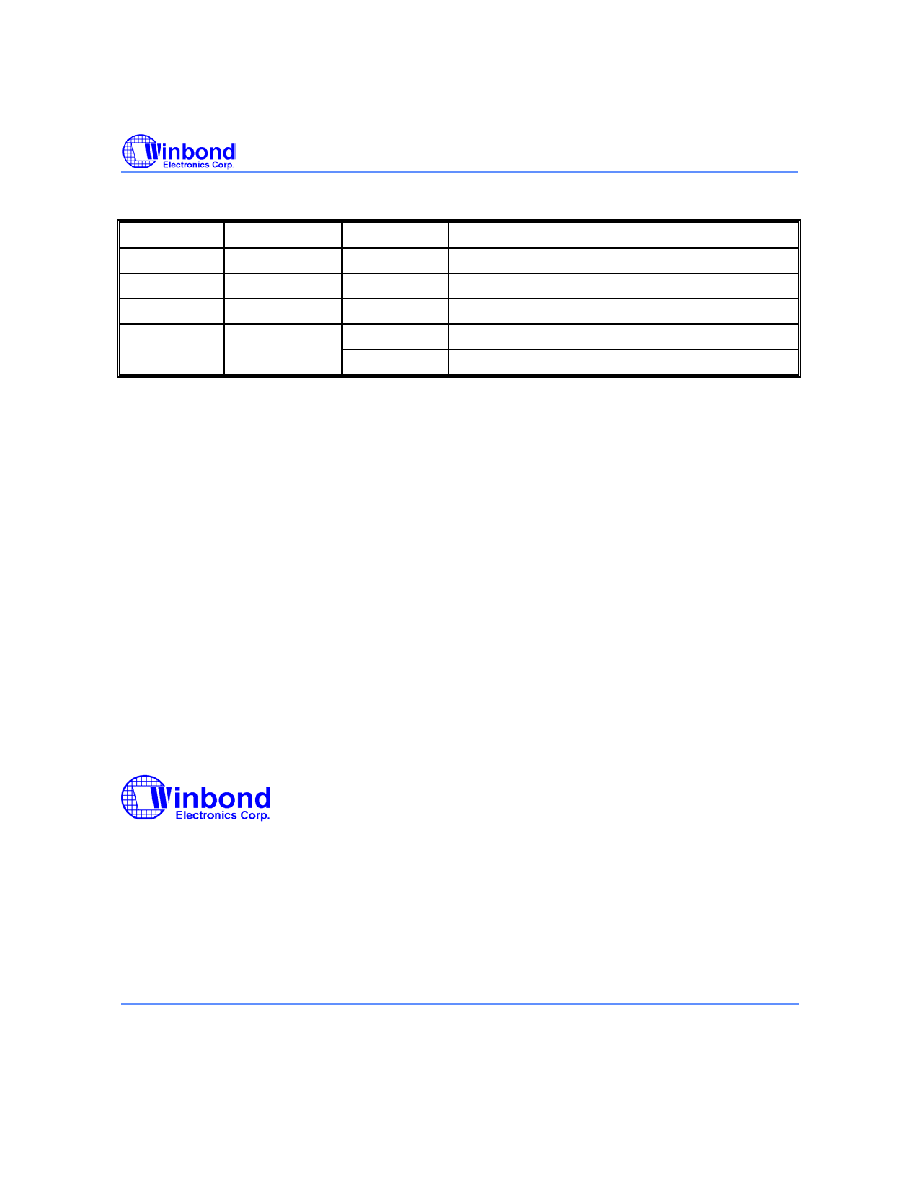
W78E858
Publication Release Date: May 5, 2004
- 33 -
Revision A4
11. VERSION HISTORY
VERSION DATE PAGE
DESCRIPTION
A
Oct. 2001
-
Initial Issued
B
Jul. 2002
15
Modify timer 2 interrupt vector address
C
Nov. 2002
5
EEPROM address of command code
D
May. 2004
6
Remove erase acquisition flow
6
Add a demo code
Headquarters
No. 4, Creation Rd. III,
Science-Based Industrial Park,
Hsinchu, Taiwan
TEL: 886-3-5770066
FAX: 886-3-5665577
http://www.winbond.com.tw/
Taipei Office
TEL: 886-2-8177-7168
FAX: 886-2-8751-3579
Winbond Electronics Corporation America
2727 North First Street, San Jose,
CA 95134, U.S.A.
TEL: 1-408-9436666
FAX: 1-408-5441798
Winbond Electronics (H.K.) Ltd.
No. 378 Kwun Tong Rd.,
Kowloon, Hong Kong
FAX: 852-27552064
Unit 9-15, 22F, Millennium City,
TEL: 852-27513100
Please note that all data and specifications are subject to change without notice.
All the trade marks of products and companies mentioned in this data sheet belong to their respective owners.
Winbond Electronics (Shanghai) Ltd.
200336 China
FAX: 86-21-62365998
27F, 2299 Yan An W. Rd. Shanghai,
TEL: 86-21-62365999
Winbond Electronics Corporation Japan
Shinyokohama Kohoku-ku,
Yokohama, 222-0033
FAX: 81-45-4781800
7F Daini-ueno BLDG, 3-7-18
TEL: 81-45-4781881
9F, No.480, Rueiguang Rd.,
Neihu District, Taipei, 114,
Taiwan, R.O.C.
































